You run an online store, juggling ads, inventory, customer messages, and the constant pressure to boost conversion rates. In AI-Powered Sales and Marketing, AI Tools for Ecommerce move those tasks from guesswork to action with personalization, recommendation engines, chatbots, predictive analytics, dynamic pricing, and inventory optimization. Want to stop wasting ad spend and miss fewer sales because of stockouts? This article shows practical steps to use these tools to run a highly profitable, AI Sales Enablement, efficient ecommerce store where AI handles the heavy lifting, boosting sales, streamlining operations, and delighting customers.
To achieve this goal, AI Acquisition's solution, the AI operating system, integrates automation, smart recommendations, and clear reporting into a single platform, enabling you to reduce waste, accelerate growth, and deliver a superior customer experience.
Why Should You Leverage AI in eCommerce?

The list of tasks when running an ecommerce business seems endless. You know it:
Uploading products
Supporting customers
Keeping track of inventory
Providing a personalized experience
Marketing your products
Speeding up your page load times
SEO optimizing your website
The good news is that, with the rise of artificial intelligence in recent years, many of these tasks can be automated, freeing up brain power to focus on your company's strategic development.
Looking for AI tools means you may be past the stage of asking yourself: “Should I adopt AI?” If you are still wondering, here are a couple of reasons why you should go down the AI path: Over 50 percent of ecommerce businesses have adopted AI technologies.
The Cost of Inaction: How Skipping AI Adoption Erodes Profit and Efficiency
AI-driven personalized recommendations contribute to a 15 to 20 percent increase in conversion rates. AI can lower client acquisition costs by up to 50 percent. AI is believed to help retailers save up to 340 billion dollars annually.
AI-powered forecasting can help businesses reduce inventory costs by up to 75 percent. In a nutshell, failing to adopt AI means losing money and falling further behind competitors, which is reflected in revenue and wasted hours. Read on to see how AI can help each core task you juggle.
Automate Product Uploads And Catalog Management
Uploading products can eat up hours when you scale. Use computer vision to:
Auto-tag images
Generate alt text for SEO
Extract specifications from supplier data sheets
Use AI-powered content generation to write product titles, descriptions, and attributes that match search intent and boost conversion.
Feed management tools will map your:
Catalog to marketplaces
Classify products into categories
Normalize SKUs automatically
That reduces manual errors, speeds time to market, and improves organic discoverability through better metadata and structured data.
Support Customers with Smarter, Cheaper Service
AI chatbots and virtual agents answer:
Common support questions 24/7
Resolve returns
Offer order updates
Escalate only complex issues to humans
Natural language processing gives bots context so they resolve problems faster and sound more human.
Conversational AI cuts support costs while preserving satisfaction when integrated with CRM and help desk platforms. Which repetitive tickets could your bot close right now, and how much would that save on labor?
Keep Inventory Tight with Demand Forecasting and Automatic Replenishment
Inventory forecasting driven by machine learning reads:
Seasonality
Promotions
Product life cycles
External signals such as:
Weather
Social trends
That reduces stockouts and dead stock. Predictive analytics can trigger reorder points and suggest safety stock, cutting holding costs dramatically. Use demand sensing to adjust orders in real time and link forecasts to your ERP or supplier portals through APIs for automatic purchase orders.
Deliver Personalization That Customers Expect
Consumers now expect experiences tailored to them. Recommendation engines infer intent from behavior across sessions and channels, serving product recommendations, triggered emails, and on-site merchandising that raise average order value.
Customer segmentation using clustering and predictive scoring supports targeted promotions and dynamic content.
To present the right product at the right moment, personalization systems use:
Collaborative filtering
Content-based ranking
Contextual signals
Make Marketing Smarter and More Efficient
AI optimizes ad spend through automated bidding and audience lookalike modeling. It generates ad creative variants, headlines, and email subject lines that score higher on click rates and conversions.
Attribution models using machine learning paint a clearer picture of what channels drive revenue so that you can cut wasted spend. Predictive LTV models let you dial CAC allowances by customer cohort and optimize acquisition funnels.
Speed Up Page Load and Improve Conversion Performance
AI helps compress images intelligently, serve adaptive media, and select the right assets for each device to speed page load. Edge inference and content optimization tools serve personalized content fragments without rebuilding full pages.
Faster pages reduce bounce rate and lift conversion, and they also improve SEO signals that search engines use for ranking.
Boost Search Ranking with Automated SEO and Semantic Search
Use AI to analyze keyword gaps, generate on-page meta tags, and create schema markup for rich results. Semantic search and natural language understanding improve internal site search, enabling shoppers to find products faster.
Content generation tools help scale category pages, blog posts, and FAQ content that target long tail intent and support organic traffic growth.
Practical Examples You Can Implement This Month
Recommendation engines that show curated buys on product pages and cart pages typically drive a measurable bump in revenue. Chatbots that handle tracking, returns, and FAQs can significantly reduce live agent load and lower average handling costs.
Automated image tagging speeds catalog onboarding and reduces misclassified goods. Predictive reorder systems prevent costly stockouts before they appear.
What To Look For In AI Tools For eCommerce
Put simply: The AI tools you adopt must elevate your business performance by answering your specific needs without disrupting your established workflow and putting you or your customers at security risk. Apply this approach to every tool, service, solution, and plugin you integrate into your business.
Use the following checklist while evaluating AI tools and any other vendor.
Will It Fit With My Existing Tech Stack Without Headaches?
How does the AI tool integrate with existing platforms and technologies on my website?
Check compatibility with your:
CMS
CRM
Analytics
Payment gateway
eCommerce platform
Look for APIs, pre-built connectors, and partner integrations that let you plug the tool into production quickly.
Does It Offer The Right AI capabilities For My Goals?
What specific AI capabilities does the tool offer, and how do they align with my website needs?
Compare features like:
Machine learning based forecasting
Natural language processing for chat
Image recognition for product tagging
Automated copy generation
Match capabilities to the problem you want to solve, not to buzzwords.
Can It Scale When Your Traffic Spikes?
Can the AI tool adapt to my website's scale and traffic fluctuations?
Confirm:
Autoscaling
Rate limits
How models behave under load
You do not want a solution that slows your site during a flash sale or a viral moment.
What Data Does It Need, and How Is That Handled?
What kind of data does the AI tool require, and how will it collect, process, and store that data?
Check:
Data flow diagrams
Encryption standards
Access controls
Retention policies
Make sure the tool supports compliance with:
GDPR
CCPA
Other applicable rules
Is It Simple for My Team and Clear for Customers?
How user-friendly is the AI tool interface for my team and website visitors?
Look for:
Intuitive dashboards
Low-code or no-code workflows
Clear fallback paths if the AI fails
Notice how IKEA lets customers place furniture in their rooms with an augmented reality app as an example of a low-friction experience.
Can I Brand and Tune It To My Voice?
What customization options does the AI tool offer to align with my brand and website design? Ensure you can tweak tone, visuals, ranking rules, and content templates so the AI output feels native to your site.
Will I Be Able to Measure Impact?
How does the AI tool measure and report on its performance and impact on my website goals? Look for A/B testing hooks, attribution metrics, uplift analysis, and KPI dashboards so you can validate ROI and iterate.
What Support and Training Do They Provide?
What support, training, and resources does the AI provider offer to ensure successful implementation and ongoing use? Evaluate onboarding programs, technical documentation, dedicated success managers, and community resources that help your team move faster.
Will It Learn and Improve From Use?
What is the feedback loop for improving the AI tool based on performance data and user interactions?
To improve accuracy over time, confirm:
How models retrain
How often updates happen
Whether you can label data or provide human-in-the-loop corrections
What are the Real Costs and Expected ROI?
What are the financial implications of adopting this AI tool, including setup costs, subscription fees, and potential ROI?
Add:
Implementation time
Training costs
Are there any fees per API call or per seat?
Model the payoff in:
Saved labor
Higher conversion
Reduced returns
Lower inventory carrying costs
Security, Privacy, and Governance You Must Demand
Ask about:
Data residency
Encryption
Access controls
Model explainability
Insist on clear SLAs and breach response plans. Use role-based access to control who can export customer data or change model behavior, and log all changes for auditability.
Questions to Engage Your Team Right Now
Which manual tasks cause the most delays on product launches?
Which support tickets repeat daily and could be routed to a bot?
Which product pages have the lowest conversion but high traffic, where AI-generated content or personalization could help?
A Practical Rollout Plan to Reduce Risk
Start with one targeted pilot that solves:
Measurable problem
Instrument it for clear KPIs
Run an A/B test
Iterate
Integrate with your stack, train the model on your data, and initially expose no more than one or two customer touch points to refine the experience without significant exposure.
Signals Of A High-Quality Vendor
Transparent performance metrics
Precise data practices
An active product road map
Case studies with comparable merchants
Referenceable customers
Vendors who provide sandbox environments and strong developer APIs shorten your time to value.
How Does This Change Roles Inside Your Company
Automation frees merchandisers to:
Focus on assortment strategy
Let marketers focus on creative funnels instead of manual audience building
Let operations staff manage exceptions instead of routine orders
Your team transitions from repetitive tasks to strategic decision-making with improved data.
Tools And Techniques To Watch This Year
Predictive pricing that:
Adjusts margins to market conditions
Image search and visual discovery for product discovery
Automated lifestyle content generation
Voice commerce enabled by natural language models
Causal attribution that clarifies what drives incremental revenue
Common Pitfalls and How to Avoid Them
Relying on out-of-the-box models without training on your data, skipping monitoring so models drift, and ignoring privacy constraints. Avoid tool proliferation by consolidating vendors where possible and establishing clear ownership for each AI system.
If You Want A Short Checklist To Test A Vendor In 10 Minutes
Confirm:
Integration options
Request a data flow diagram
Ask for a sample KPI uplift
Review the security summary
Ask for a sandbox or a trial
That will tell you more than marketing copy in a single meeting.
Related Reading
35 Best AI Tools for Ecommerce
1. AI Acquisition: Start and Scale an AI-Driven Business Fast

We help professionals and business owners start and scale AI-driven businesses using existing AI tools and our proprietary ai-clients.com AI operating system. You don't need a technical background, significant upfront capital, or a second 9 to 5; our system automates the heavy lifting, allowing you to focus on customers.
Check the free training to see how this exact system produced $500,000 per month in under two years. Book an AI strategy call with one of our consultants to explore how your skills align with a profitable AI business.
Key Features
ai-clients.com OS to run client workflows and automation
Training, templates, and strategy calls for nontechnical founders
Playbooks for lead generation, service delivery, and scaling
eCommerce Impact
Helps entrepreneurs launch AI services quickly and monetize skills through AI-driven offerings.
2. Lyro AI Chatbot: Conversational Sales and Support for Stores
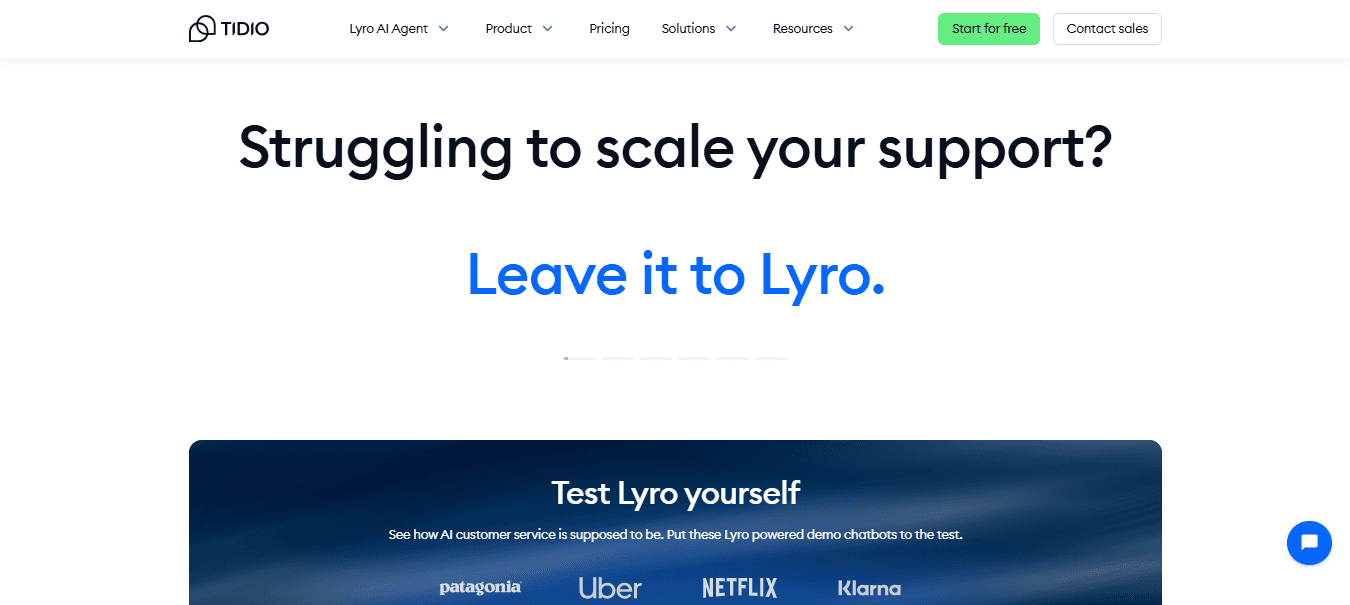
Lyro is an NLP chatbot built for ecommerce that handles product questions, inventory checks, order tracking, and troubleshooting while learning from interactions to improve over time.
Key Features
Simple configurable setup, unlimited replies per customer
Hand off to human agents anytime
Conversational product discovery and support
eCommerce Impact
Boosts conversions and reduces customer support load with 24/7 shopping assistance.
3. Nosto: Personalized Shopping at Scale
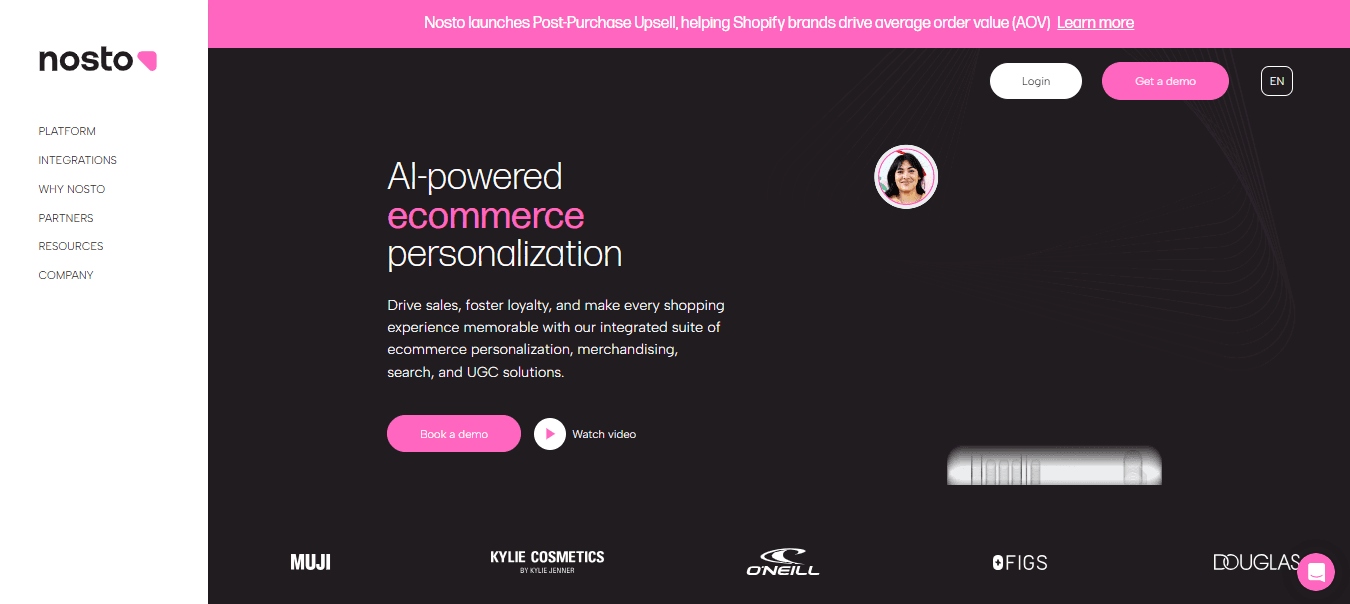
Nosto uses behavioral data, business intelligence, and real-time machine learning to deliver product recommendations, personalized content, and targeted campaigns across web, mobile, and email.
Key Features
Fast setup via API or templates
Automated personalization with controls for marketers
Engine built to avoid slowing site performance
eCommerce Impact
Increases average order value and customer engagement through tailored experiences.
4. Adobe Sensei: AI That Upsells Your Adobe Commerce
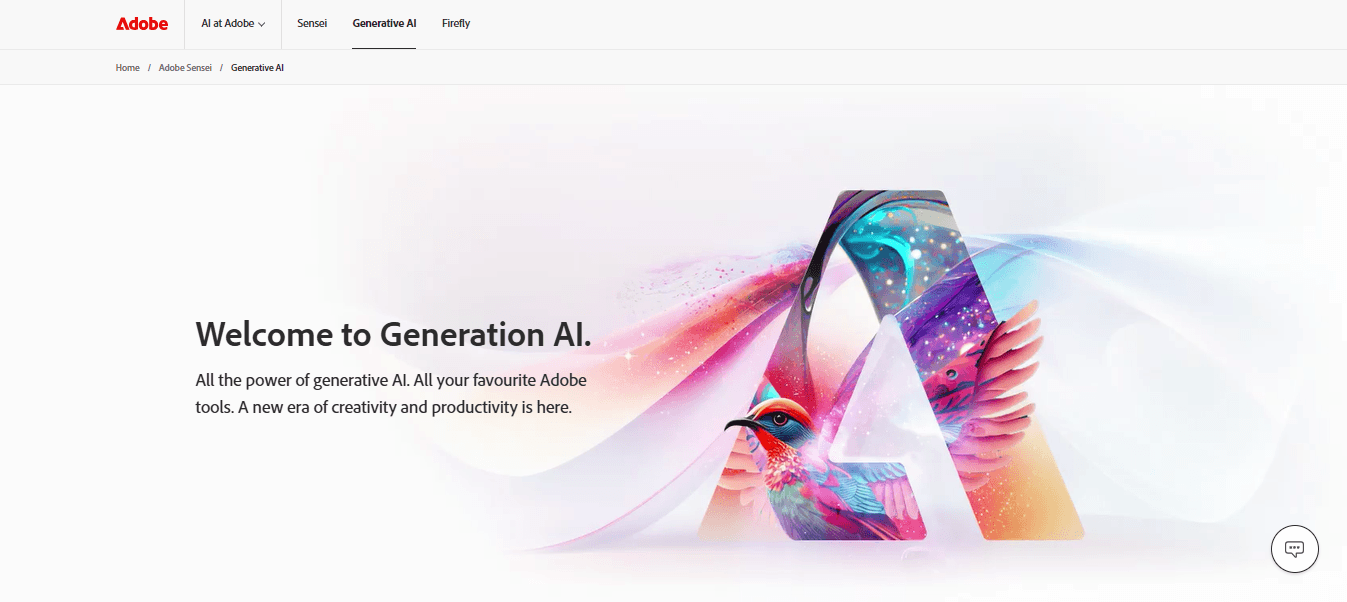
Adobe Sensei powers personalization, predictive search, image tagging, and automated catalog tasks inside Adobe Commerce, with generative AI for copy and recommendations.
Key Features
Marketing impact quantification across goals
Predictive lead and account movement analytics
Automated product recommendations and image analysis
eCommerce Impact
Streamlines merchandising and personalization to boost conversion rates and minimize manual catalog work.
5. Plerdy: UX and CRO Insights That Drive Action
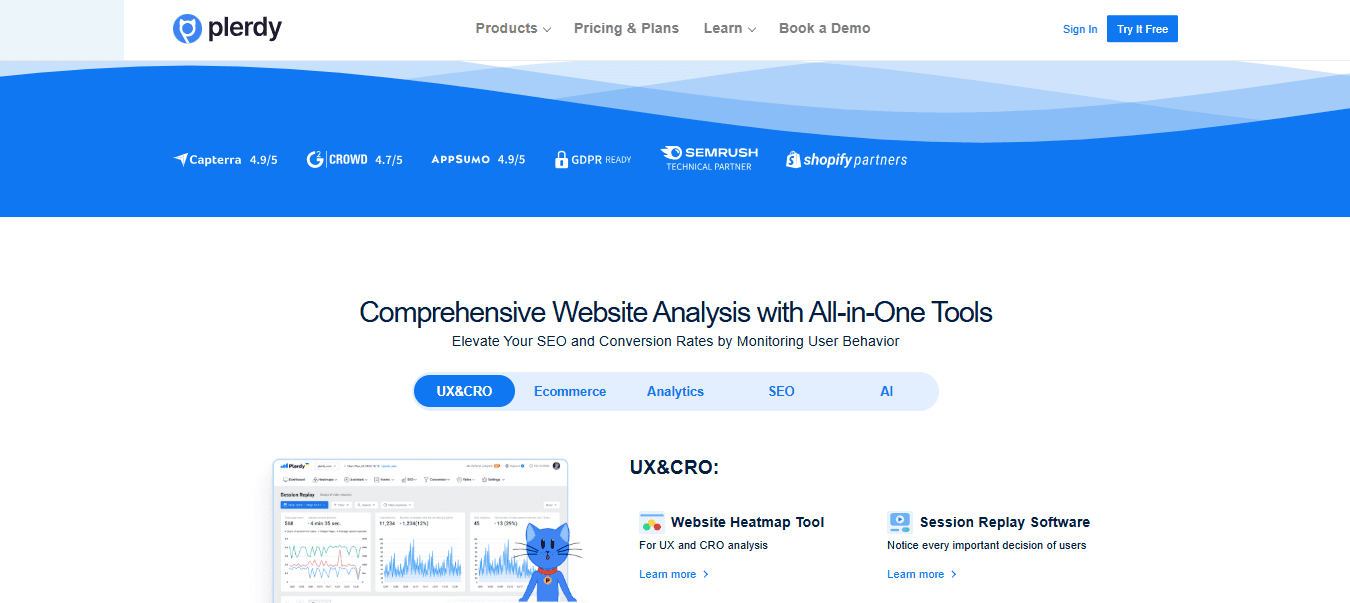
Plerdy’s AI UX Assistant analyzes clicks, behavior, and conversion bottlenecks to produce actionable CRO recommendations you can implement quickly.
Key Features
AI-powered UX and conversion analysis
Clear, actionable advice for web improvements
Lightweight integration that won’t slow the site
eCommerce Impact
Improves conversion rate and user experience with data-driven fixes.
6. Navigation AI by Uxify: Instant Pages, Faster Browsing
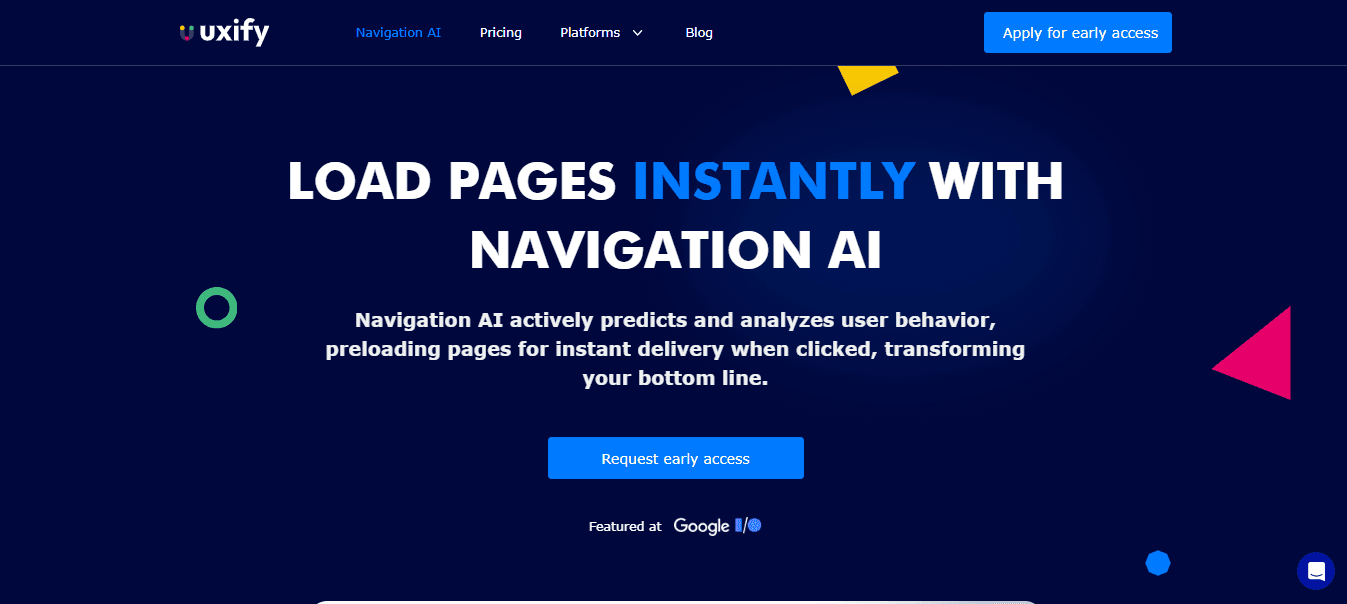
Navigation AI predicts which page a user will click next and prerenders or prefetches it to create instantaneous navigation and better engagement.
Key Features
Short JavaScript snippet for quick install
Platform agnostic, works on any site
Improves Core Web Vitals and click-through metrics
eCommerce Impact
Reduces friction, increases time on site, and boosts conversions through faster browsing.
7. Algolia: Search and Discovery That Sells
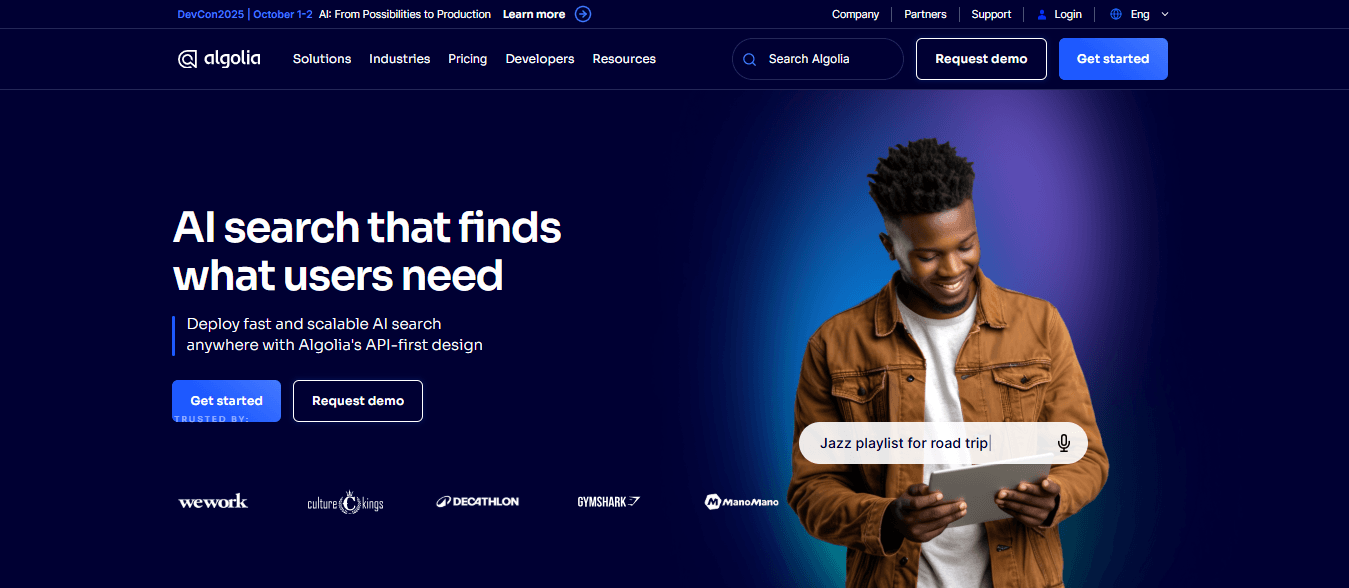
Algolia is an API-first search and discovery engine that applies AI to understand intent and surface relevant products as users type and browse.
Key Features
Personalized search results and recommendations
Trending content boosts and intelligent experimentation
Prioritizes metrics like profitability and inventory
eCommerce Impact
Raises findability and conversion by making search fast and relevant.
8. Klaviyo: Email and Owned Channel AI Automation
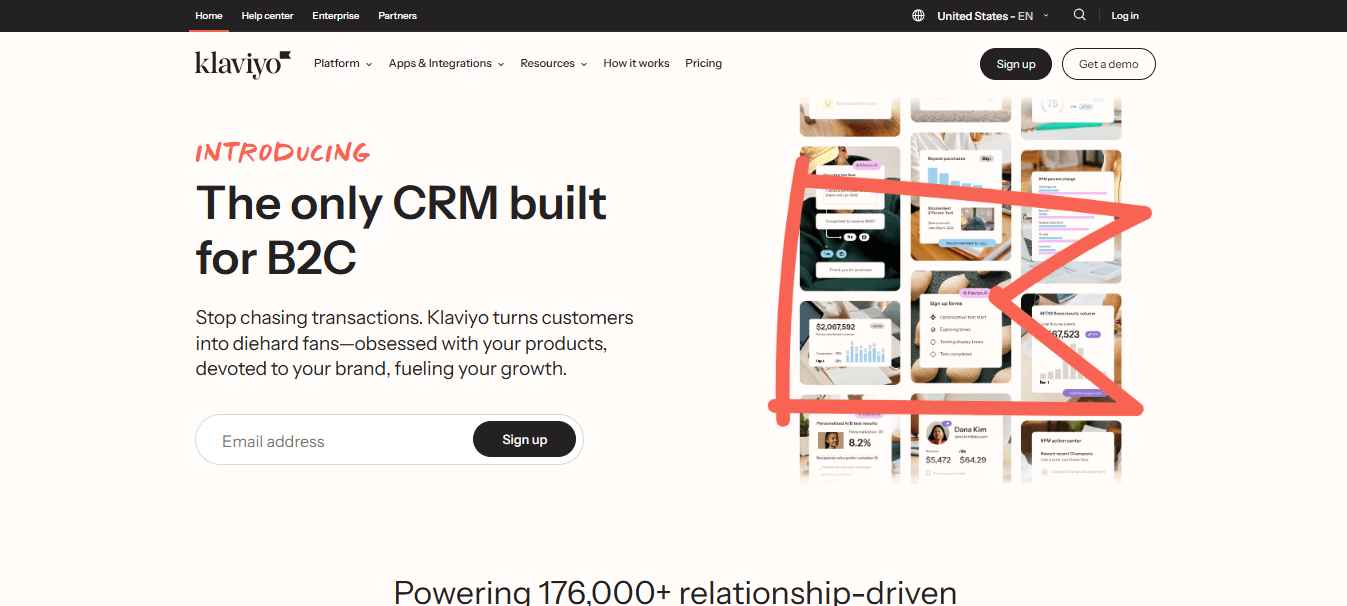
Klaviyo uses machine learning to power segmented email and SMS campaigns, predictive lifetime value, and timing recommendations for audience outreach.
Key Features
Predictive analytics for next order date and CLTV
AI-powered send time optimization
Easy audience segmentation via natural descriptions
eCommerce Impact
Boosts repeat purchases and improves ROI on owned marketing channels.
9. Buffer AI Assistant: Smarter Social Content and Scheduling
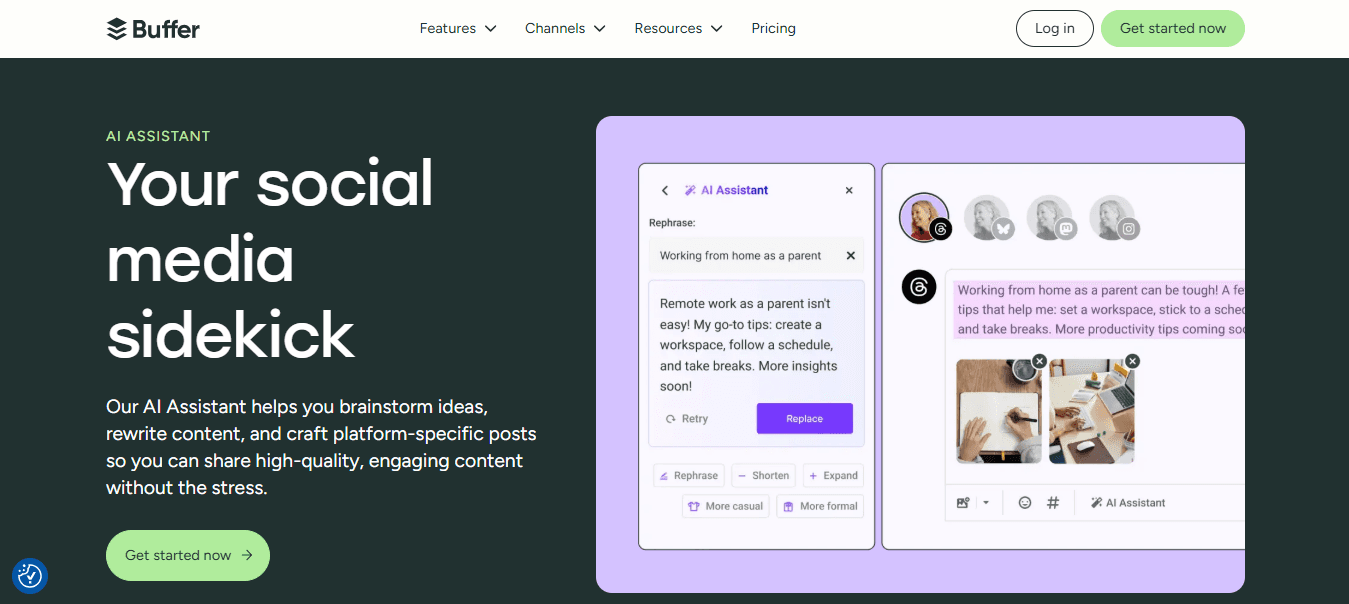
Buffer’s AI Assistant helps create social posts, repurpose content, and recommend optimal posting times to increase social reach.
Key Features
Generate engaging social posts quickly
Endless content idea generation
Automatic repurposing across channels
eCommerce Impact
Increases brand reach and saves time on social media management.
10. forms.app: AI Forms, Surveys, and Mini-Shops
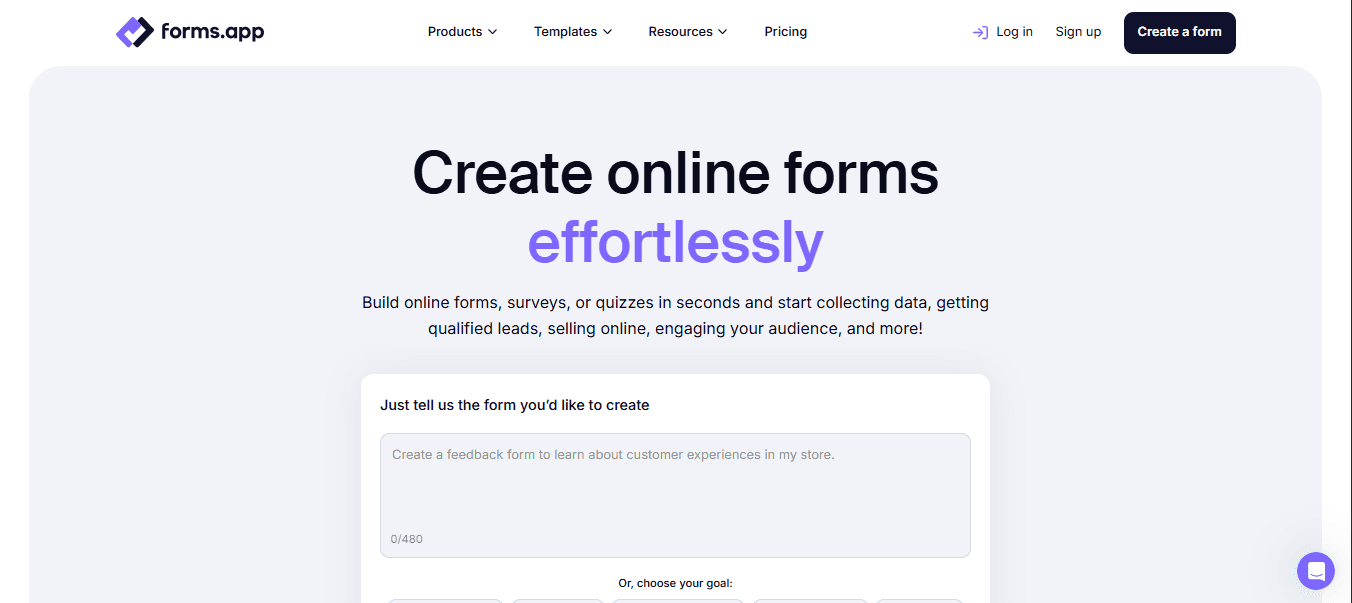
forms.app is a form and survey builder with an AI generator that creates form fields and options from a simple prompt, includes conditional logic, and payment collection.
Key Features
25 plus field types and product basket for stores
AI form generator and conditional logic
500-plus third-party integrations
eCommerce Impact
Streamlines customer data capture, preorders, and lead collection to feed marketing funnels.
11. Salesforce Einstein: CRM AI That Personalizes at Scale
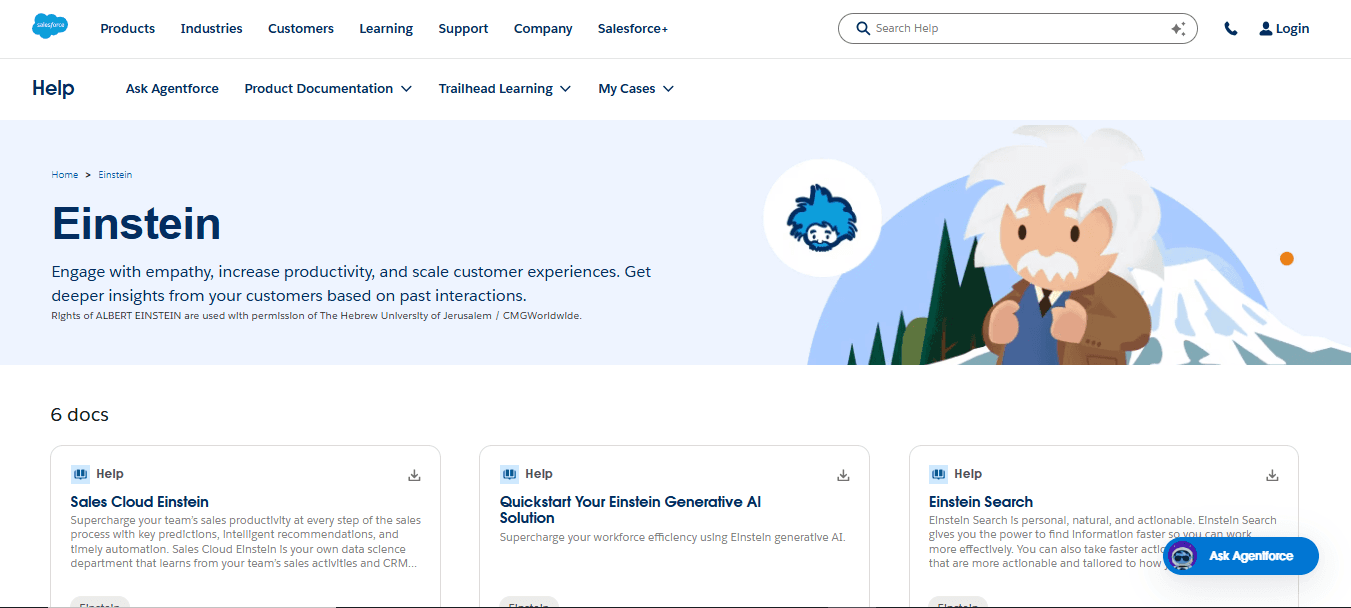
Einstein embeds AI into Salesforce CRM to produce product descriptions, merchandising insights, and predictive behavior models for eCommerce sellers.
Key Features
Einstein GPT for product copy generation
Commerce Insights for merchandising decisions
Automated complementary product sets to increase AOV
eCommerce Impact
Enhance personalization and automate email and merchandising decisions to boost conversion rates.
12. OptiMonk AI: Onsite Personalization and Page-Level Offers
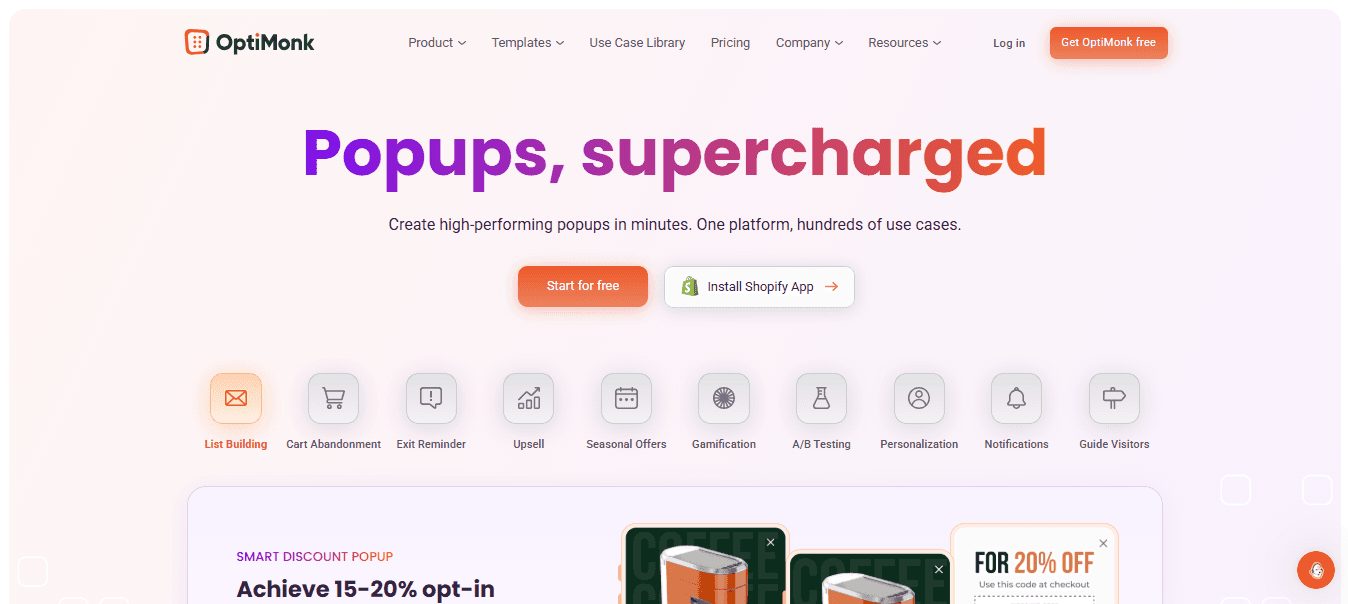
OptiMonk uses real-time visitor signals to present targeted pop-ups, product recommendations, and personalized landing page content to different segments.
Key Features
Auto-generated conversion-optimized headlines and descriptions
Behavior-based pop-ups and onsite personalization
Segmentation by product views and engagement stage
eCommerce Impact
Lifts revenue from onsite engagement and reduces cart abandonment with timely offers.
13. Competera: Competitive Intelligence and Pricing Signals
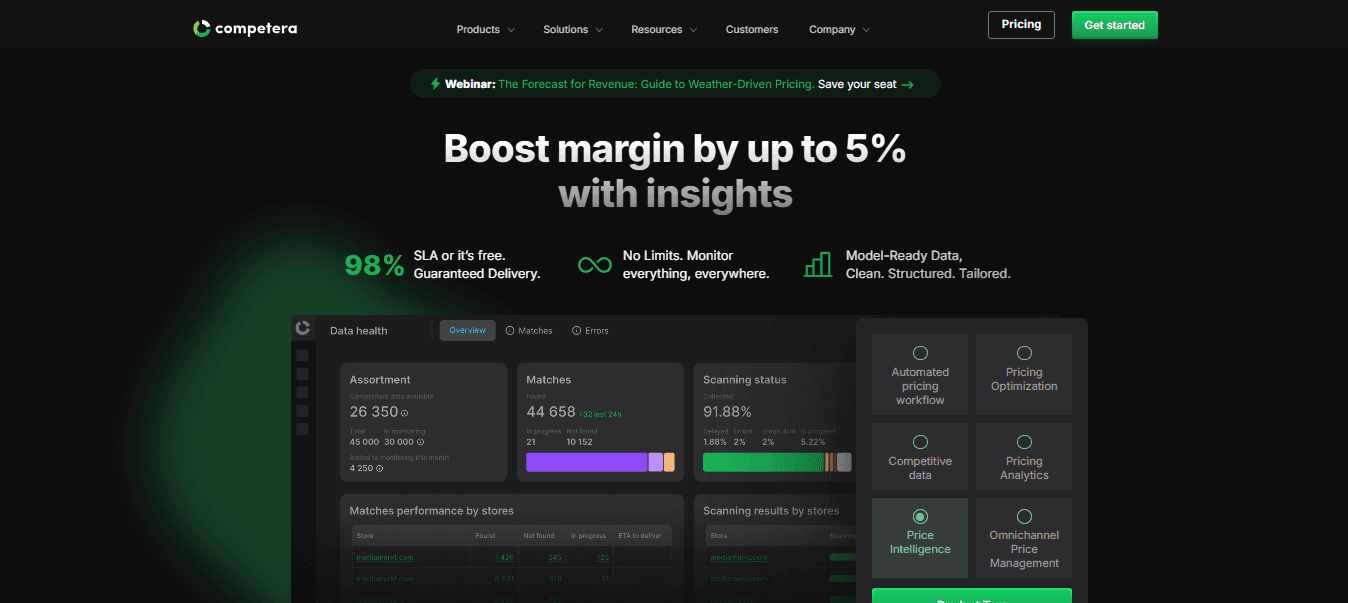
Competera monitors competitors, pricing, promotions, and assortment to give you market-aware pricing and assortment strategies.
Key Features
Real-time alerts on competitor changes
Deep analytics that reveal market trends and gaps
Human and automated QA for data accuracy
eCommerce Impact
Helps you stay price competitive and capture market share with evidence-based pricing moves.
14. Kount: Dual-Mode Fraud Detection and Risk Control
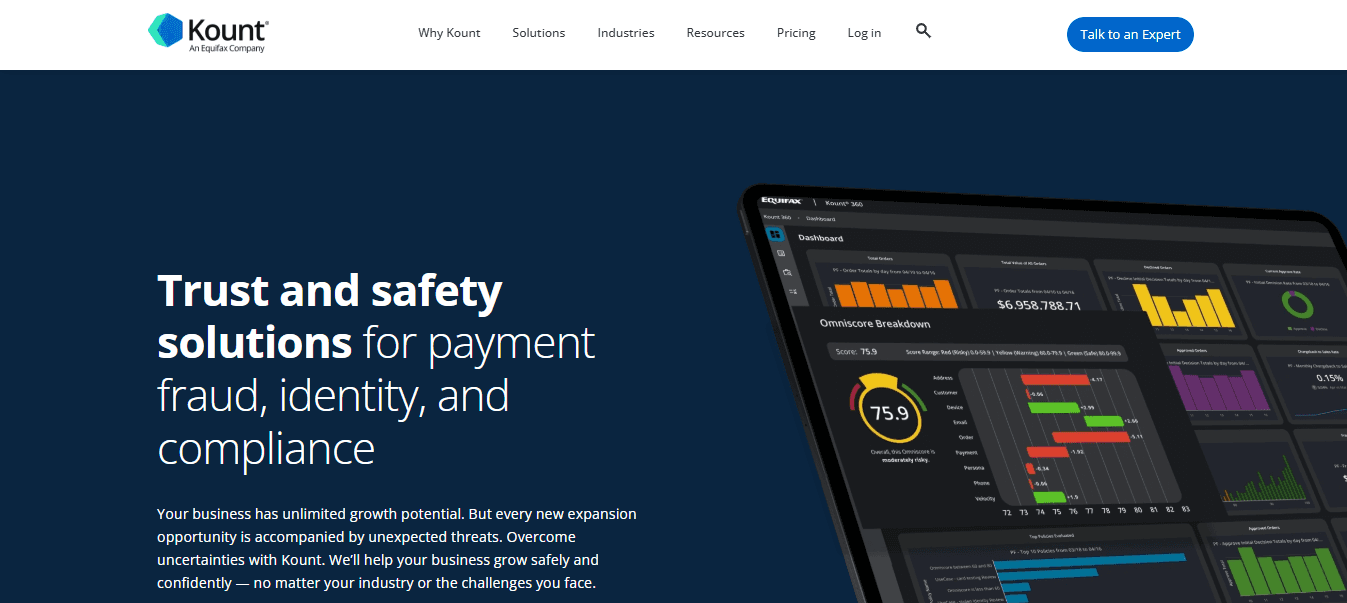
Kount uses supervised and unsupervised machine learning to score transactions and stop fraud while explaining decisions for policy tuning.
Key Features
Both supervised and unsupervised ML models
Decades of historical signals feeding models
Transparent explanations for fraud decisions
eCommerce Impact
Reduces chargebacks and false declines while improving approval rates.
15. ChatGPT: Flexible Language AI for Ecommerce Tasks
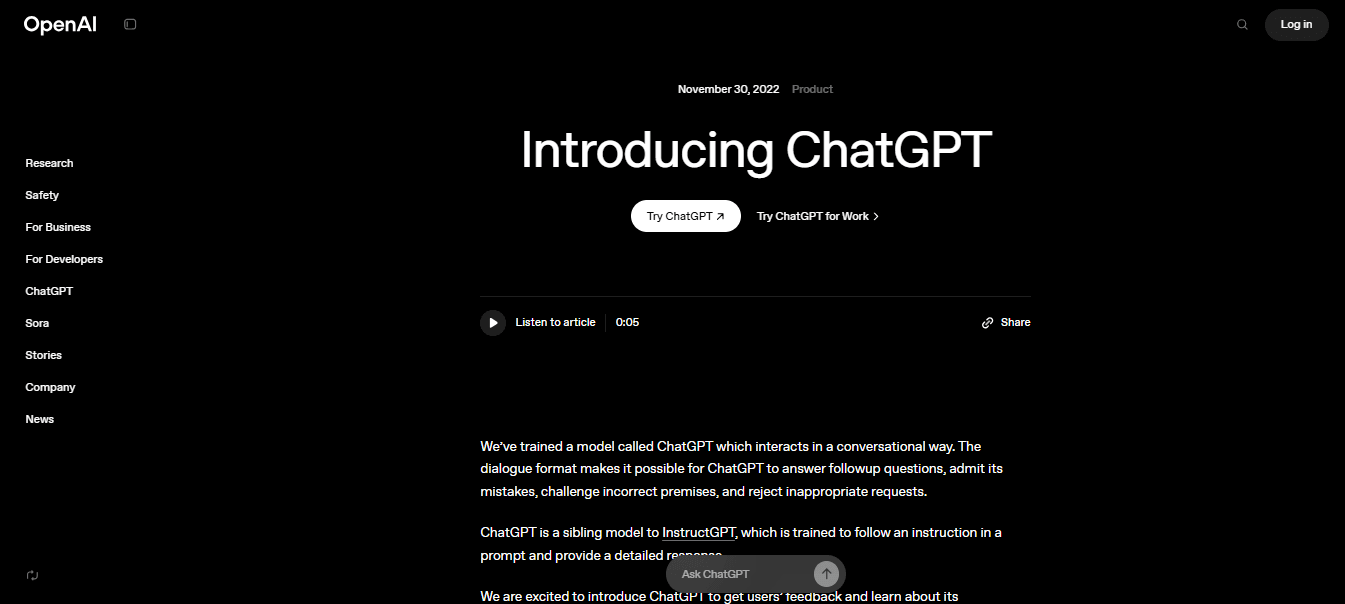
ChatGPT generates product descriptions, FAQs, customer responses, and marketing copy when fed strong prompts and business context.
Key Features
High-quality natural language generation
Easy to iterate for different tones and formats
Works across emails, chat scripts, and content briefs
eCommerce Impact
Speeds content creation and scales personalized messaging for higher conversion.
16. Jasper: High Volume Content That Converts
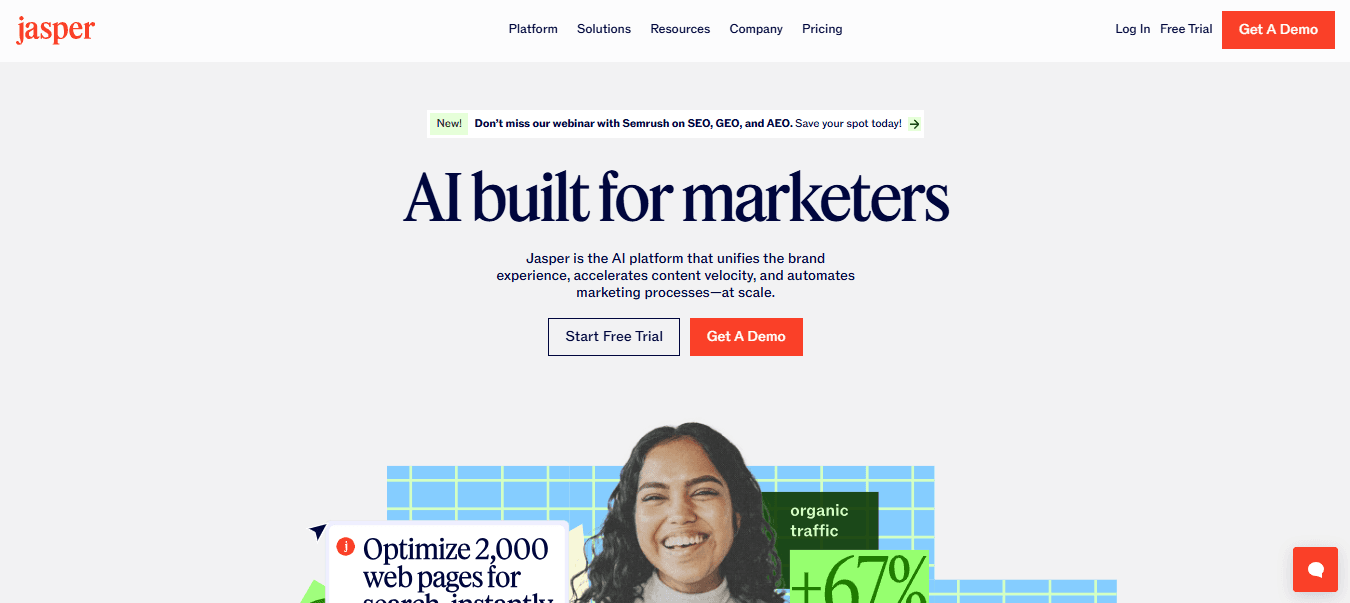
Jasper produces product descriptions, ad copy, and long-form content tuned for brand voice and SEO to support growth at scale.
Key Features
Multilingual creative copy in 30-plus languages
Insights to double down on top content and improve weak pieces
Turn single briefs into multichannel campaigns
eCommerce Impact
Streamlines content operations and enhances SEO and conversion rates through consistent messaging.
17. Sitechecker: SEO Monitoring and Issue Fixes
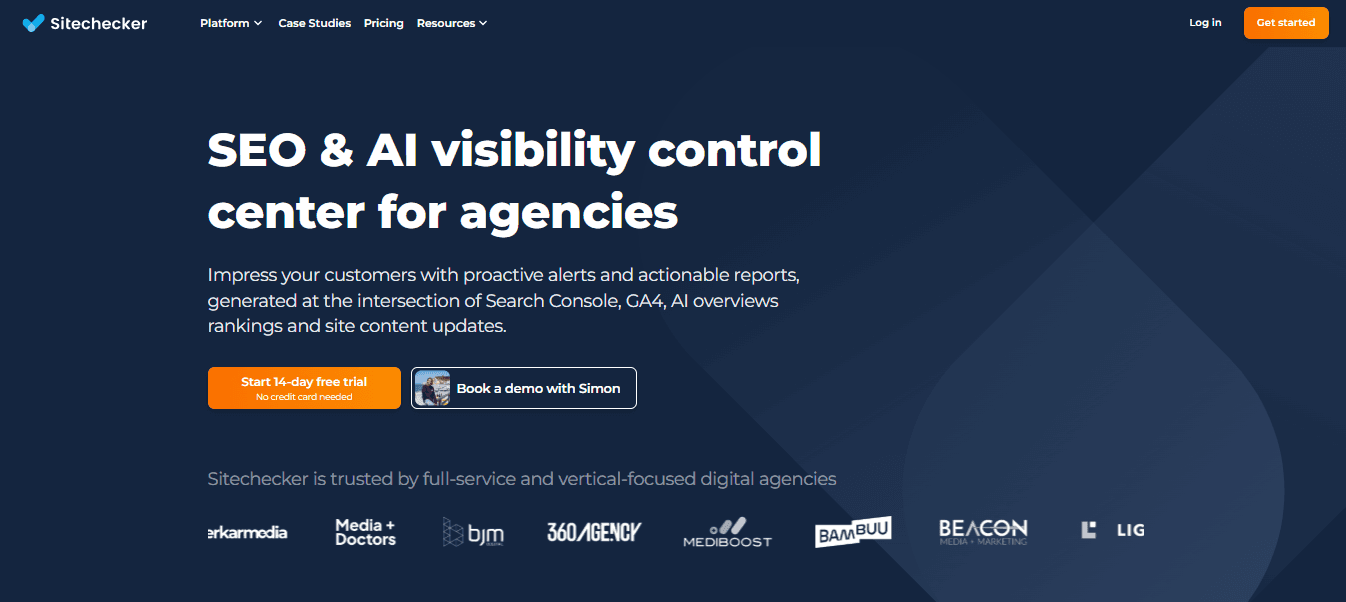
Sitechecker audits sites, tracks SEO performance, and compares competitors to give actionable recommendations for search visibility.
Key Features
AI competitor analysis
Comprehensive SEO monitoring toolset
Clean dashboard and automated reporting
eCommerce Impact
Helps fix technical SEO issues and improve organic traffic and product discoverability.
18. Surfer AI: Data Driven SEO Content Composer
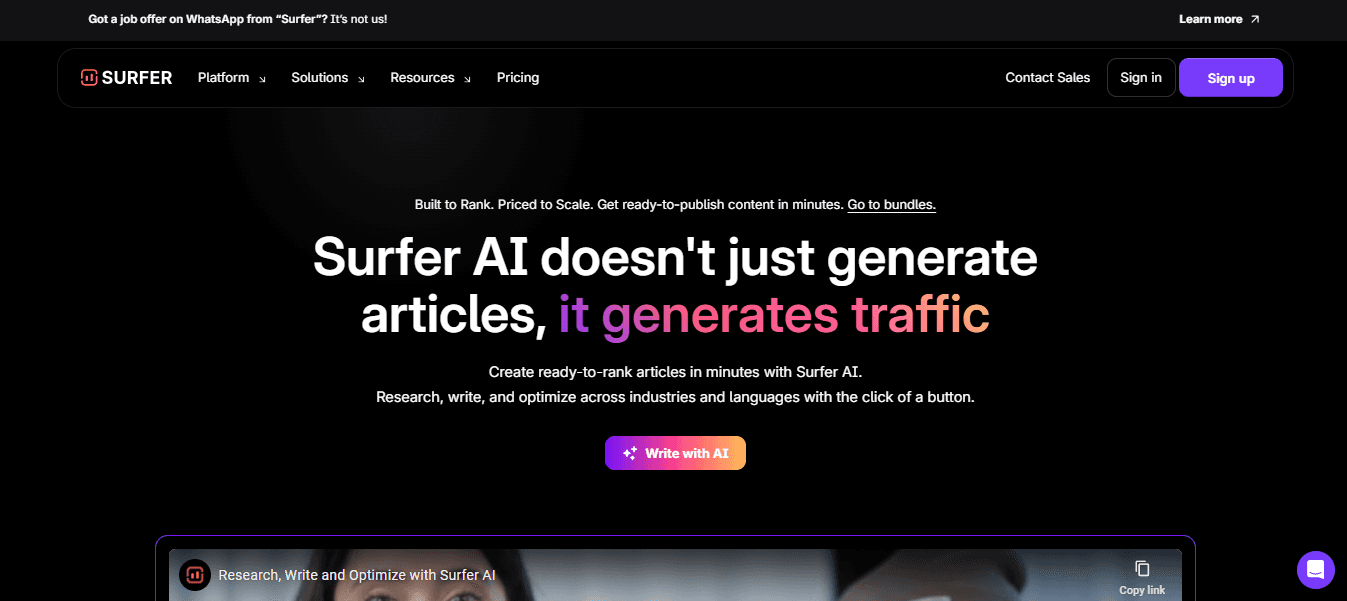
Surfer AI writes SEO friendly content by analyzing top-ranking pages and offering keyword and structure guidance in real time.
Key Features
Human-sounding content with anti-AI detection tuning
Analyzes hundreds of thousands of words for content generation
Multi-language content generation
eCommerce Impact
Raises organic visibility for product pages and category content.
19. Frase: Research-Driven Content That Ranks
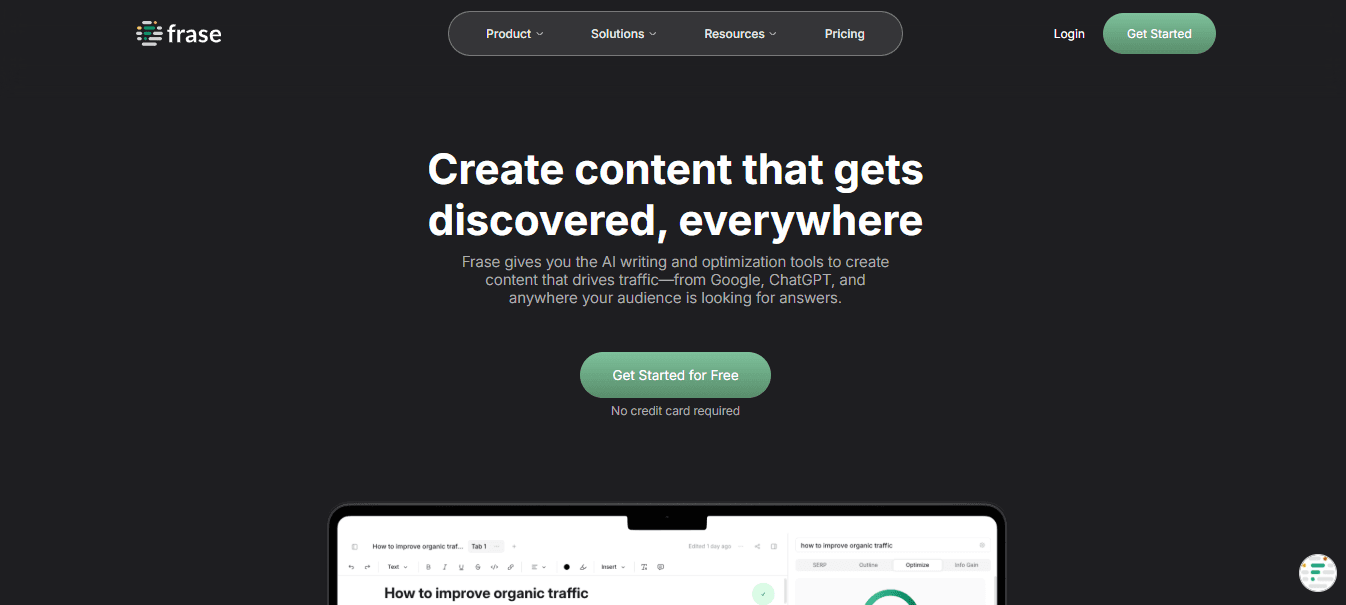
Frase builds optimized briefs, researches search intent, and crafts content that targets user queries for better ranking performance.
Key Features
Rapid AI-generated content briefs
Automated keyword and competitor comparison
Research-driven content editing tools
eCommerce Impact
Cuts time to create SEO content and improves topical relevance and ranking.
20. Synthesia: Fast AI Video for Product and Training
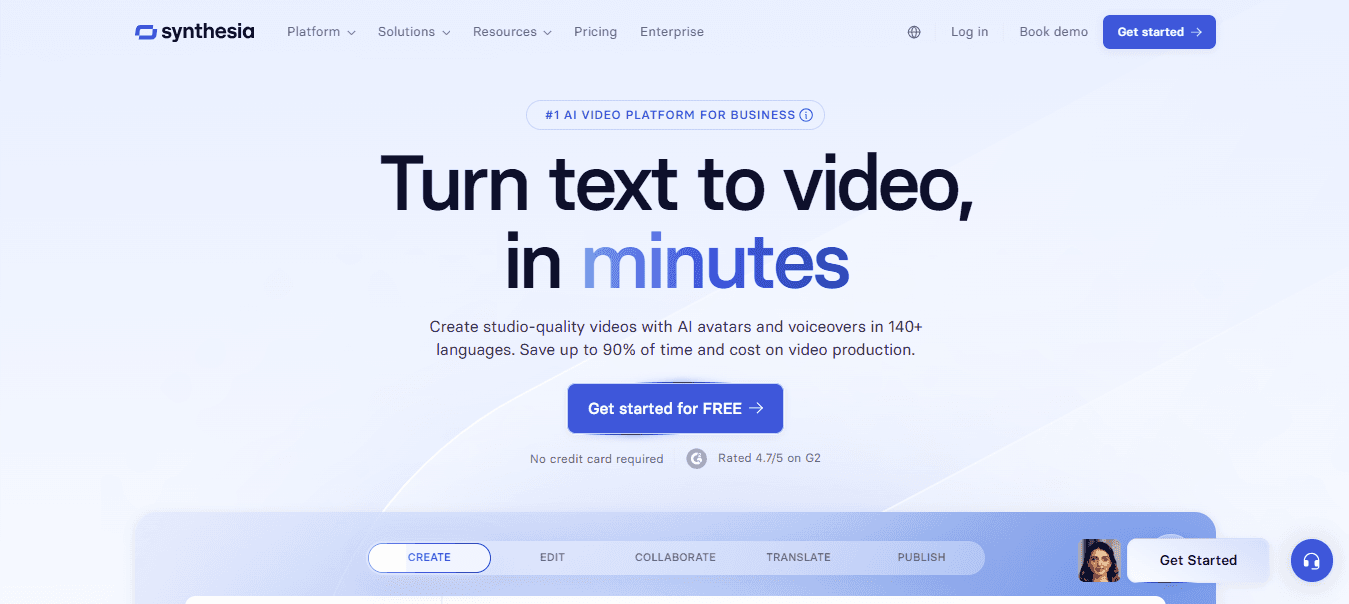
Synthesia converts text into video using AI avatars and natural voices, enabling rapid production of product demos and localized video content.
Key Features
160 avatar options and hundreds of voices
Auto translation into 120 languages
No studio or camera required
eCommerce Impact
Boosts product engagement and reduces video production costs for global audiences.
21. Hypotenuse AI: Bulk Product Content and Asset Enrichment
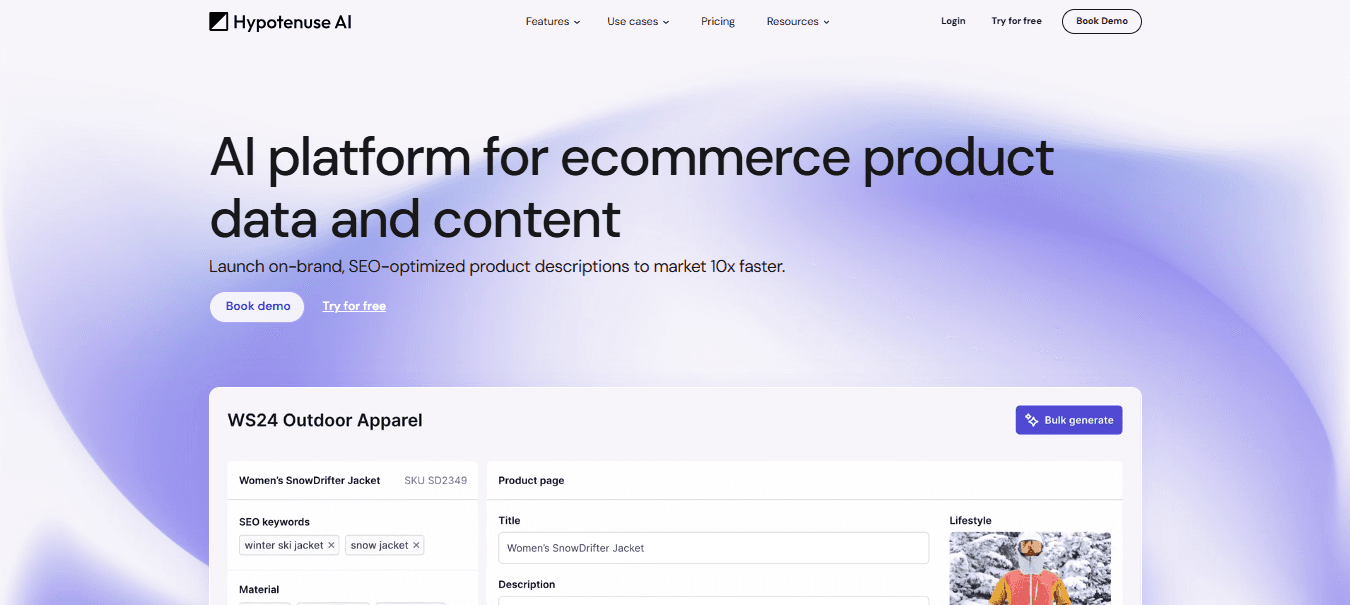
Hypotenuse AI creates SEO friendly product descriptions, enriches product data, and can edit product images for extensive catalogs.
Key Features
Bulk description and metadata generation
Automated tagging and data enrichment
Integrations with PIMs, CMS, and Shopify
eCommerce Impact
Saves hours of manual copywriting and improves catalog searchability.
22. GrammarlyGO: Polished, Brand Safe Copy
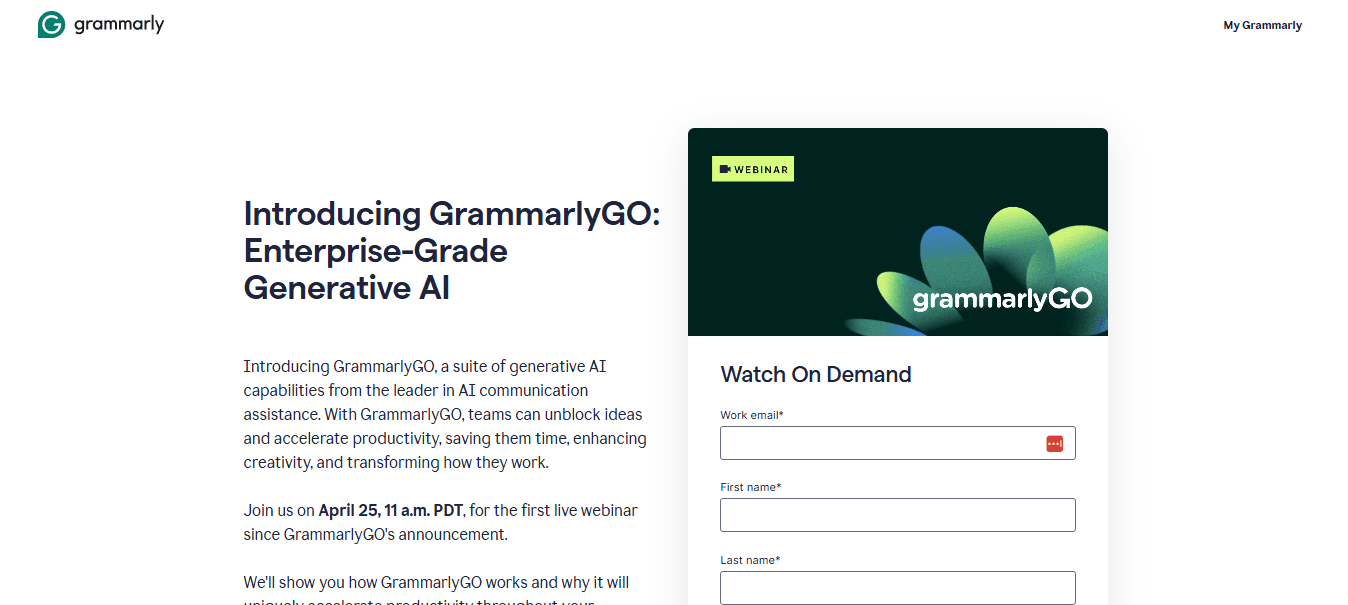
GrammarlyGO refines product descriptions, emails, and customer-facing copy to ensure clarity and on-brand voice with grammar and tone suggestions.
Key Features
Context-aware rewriting and tone adjustments
Business-focused features in the Grammarly Business plan
Writing analytics across teams
eCommerce Impact
Improves professionalism and conversion by making product messaging more transparent and more persuasive.
23. Zoho Analytics: Conversational BI and Forecasting
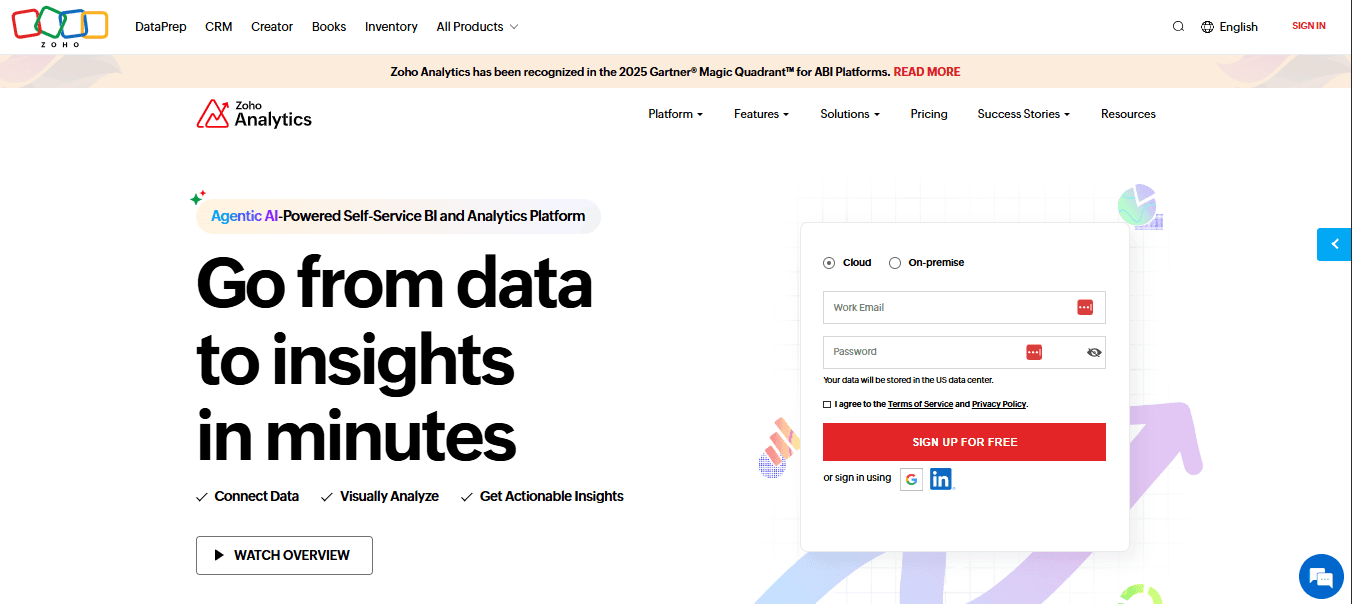
Zoho Analytics uses the Zia AI assistant for conversational queries, forecasts, and automated narrative generation from your sales and customer data.
Key Features
Ask Zia questions in natural language for instant insights
Forecasting and predictive scenarios
Mobile-friendly chat-style interface
eCommerce Impact
Empowers nontechnical teams to find trends and plan inventory, promotions, and marketing spend.
24. Qualtrics XM: Experience Signals and Predictive Actions
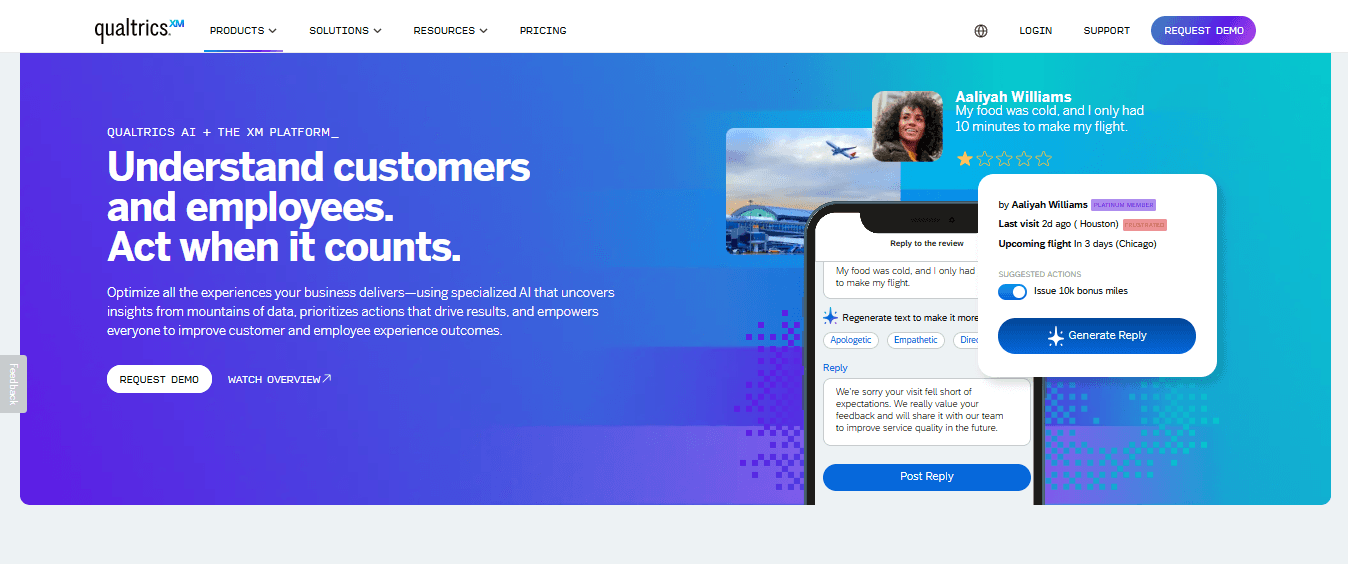
Qualtrics captures customer and employee signals across touch points and applies AI to forecast behavior and recommend next steps.
Key Features
Deep feedback analysis and visual reporting
AI-driven trend forecasting and action recommendations
Fast feedback collection and response workflows
eCommerce Impact
Improves customer experience through targeted operational and marketing actions informed by feedback.
25. Wisepops: Onsite Recommendations Beyond Widgets

Wisepops uses AI and rule logic to generate product recommendations in popups, embedded feeds, and onsite campaigns, built for Shopify stores.
Key Features
Multi-channel placements, pop-up, and embed support
Shopify sync for real-time product and segment updates
Revenue attribution and analytics built in
eCommerce Impact
Increases cross-sell and upsell revenue across onsite touch points.
26. Triple Whale: Real-Time Analytics and Automation for Growth
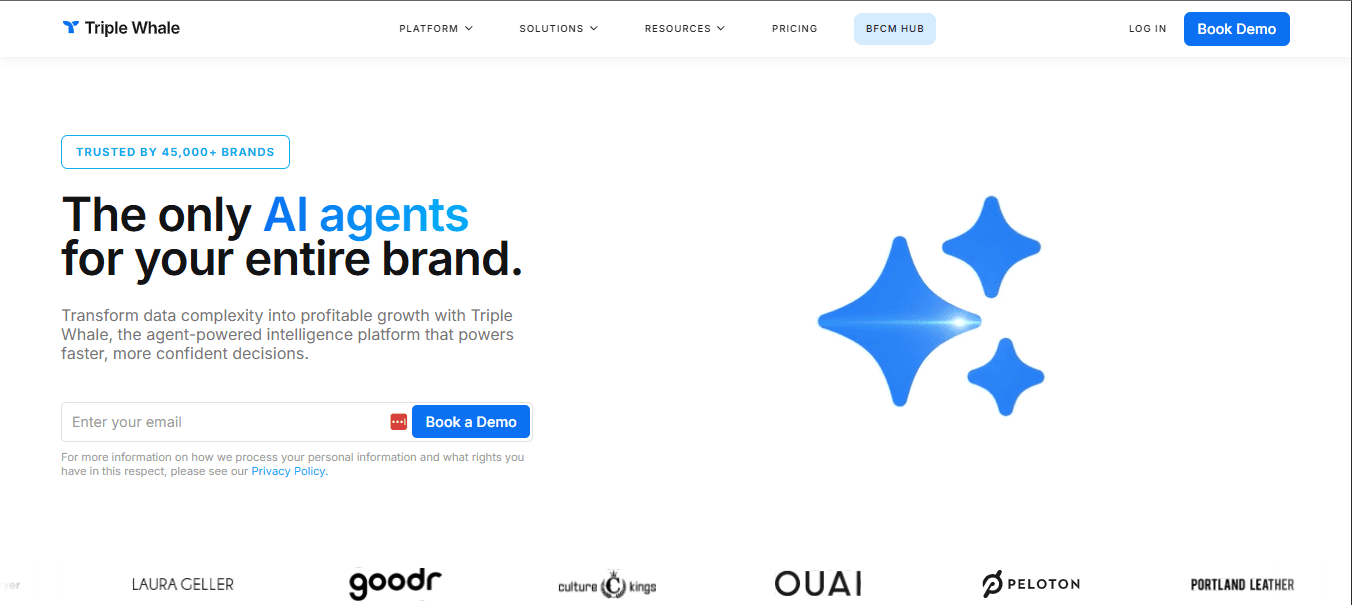
Triple Whale consolidates ad, store, and attribution data into live dashboards and automations to manage:
ROAS pacing
Spend
Revenue signal
Key Features
Real-time performance dashboards
Moby Agents for automated monitoring and alerts
Cross-channel anomaly detection and pacing automation
eCommerce Impact
Speeds decision-making and optimizes ad spend with automated monitors.
27. Inventory Planner: Demand Forecasting Made Practical
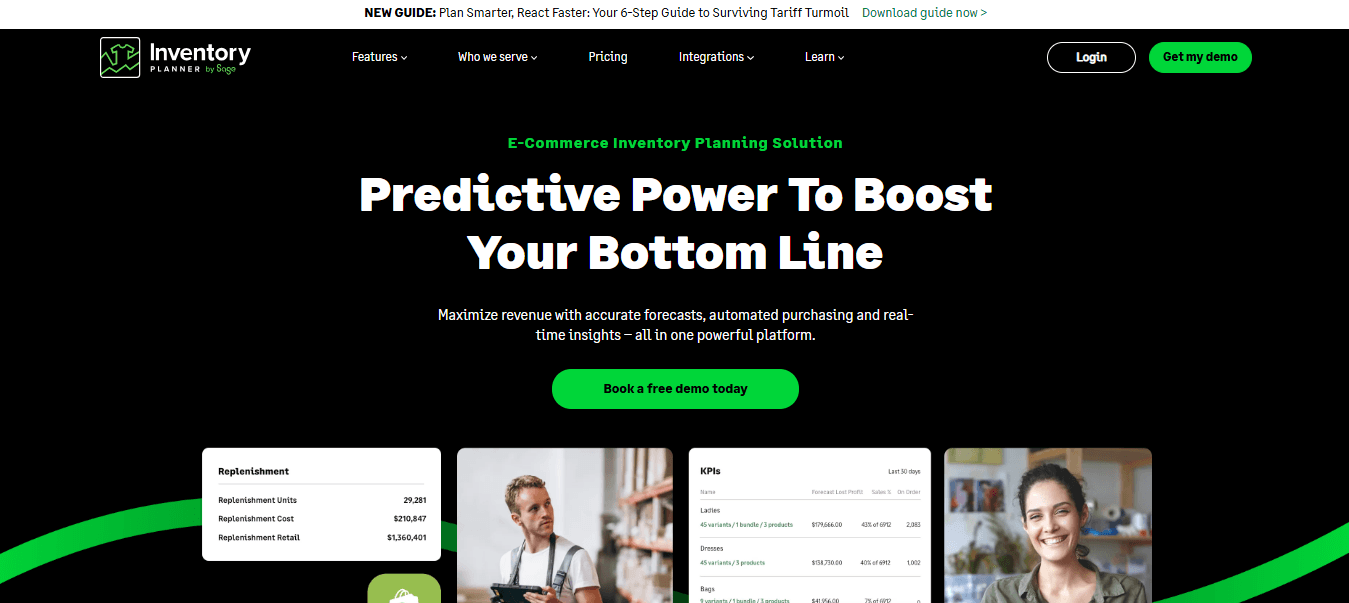
Inventory Planner predicts demand and builds purchase plans based on historical sales, seasonality, and lead times to limit stockouts and overstocks.
Key Features
Accurate demand forecasting and reorder suggestions
Integrations with major ecommerce platforms
Intuitive interface with actionable reorder plans
eCommerce Impact
Reduces stockouts and carrying costs while improving fulfillment rates.
28. Lokad: Quantitative Forecasting for Complex Supply Chains
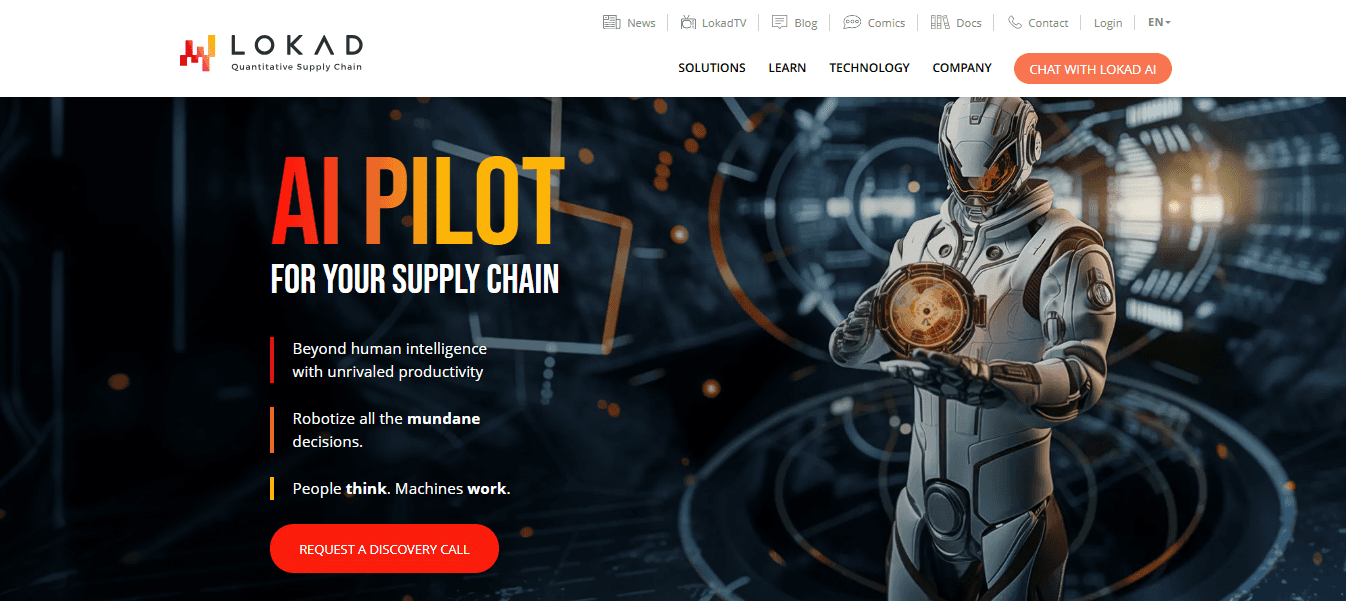
Lokad applies probabilistic forecasting and quantitative models to provide supply chain optimization for complex inventories and multi-location fulfillment.
Key Features
Probabilistic demand models
Customizable models for complex product portfolios
Rich dashboards for scenario analysis
eCommerce Impact
Improves fill rates and reduces waste by modeling uncertainty in demand.
29. Akkio: No Code AI for Fast Forecasting
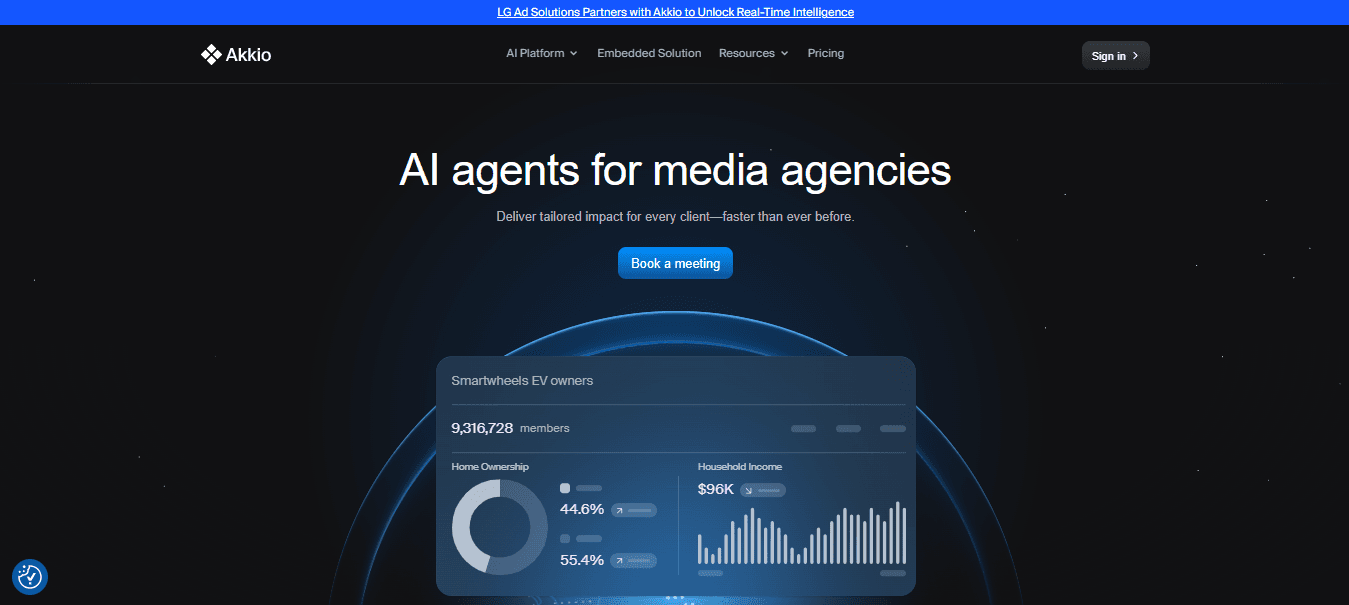
Akkio offers no-code machine learning for inventory forecasting, demand planning, and other predictions, enabling teams to build models without engineers.
Key Features
Drag and drop model creation
Real-time predictions and updates
Scales from small stores to enterprise
eCommerce Impact
Let's teams deploy forecasting quickly to improve purchasing and promotions.
30. Tableau: Visual Analytics for All Your Data
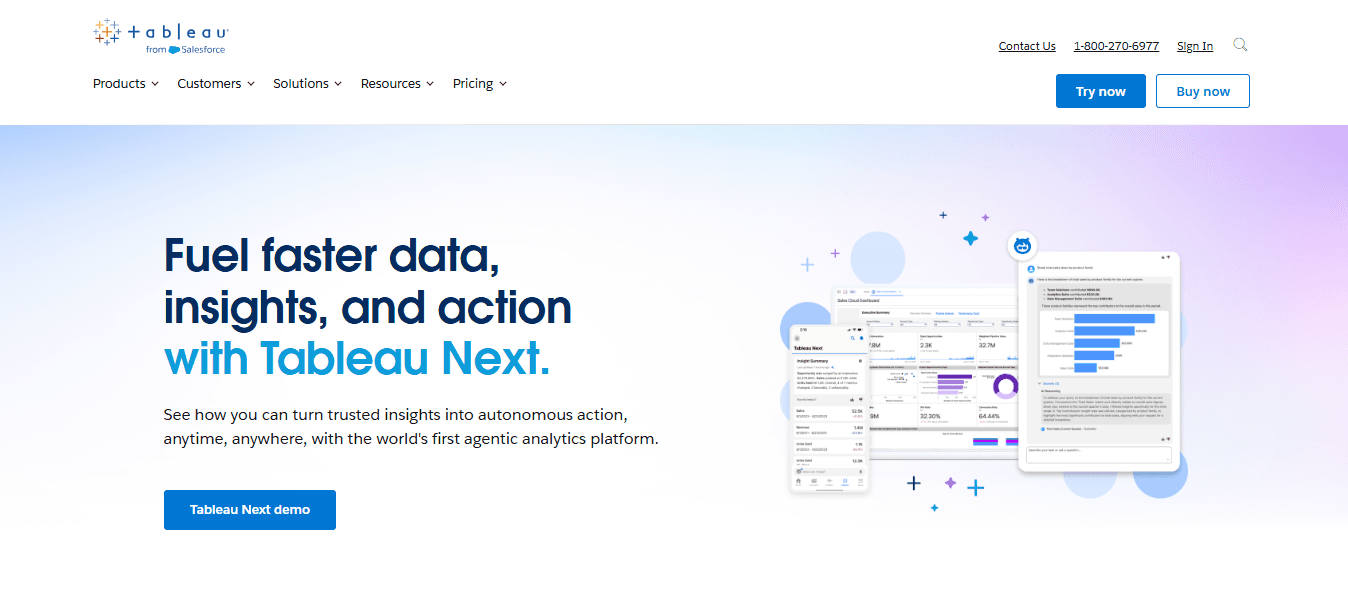
Tableau renders complex ecommerce datasets into interactive dashboards and supports predictive modeling and natural language queries.
Key Features
Highly interactive visualizations and dashboards
Scales to large data volumes and blends sources
Predictive analytics and ask data in natural language
eCommerce Impact
Clarifies performance and uncovers opportunities across merchandising, marketing, and operations.
31. Prisync: Monitor Competitor Prices and React Fast
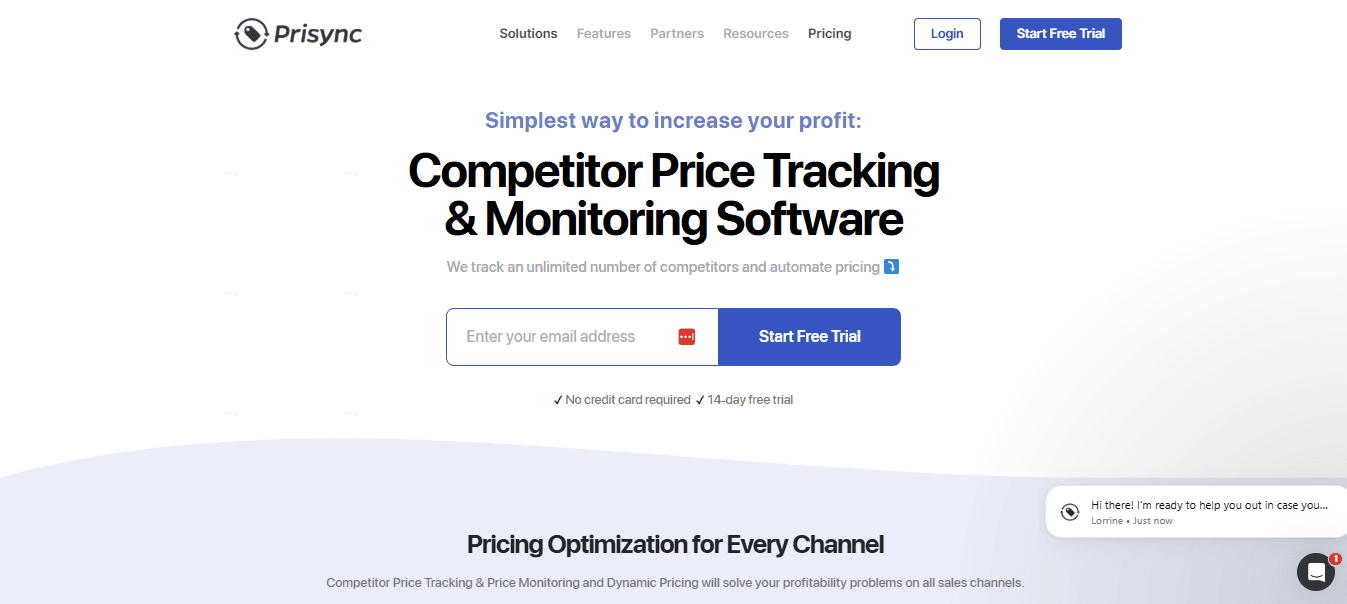
Prisync tracks competitor prices and automates dynamic pricing rules, allowing you to remain competitive without manual monitoring.
Key Features
Easy dashboard and multiple integrations
Customizable pricing rules and alerts
Global support for various currencies
eCommerce Impact
Keeps pricing competitive and protects margin with automated repricing.
32. Pricen.ai: AI-Driven Dynamic Pricing Engine
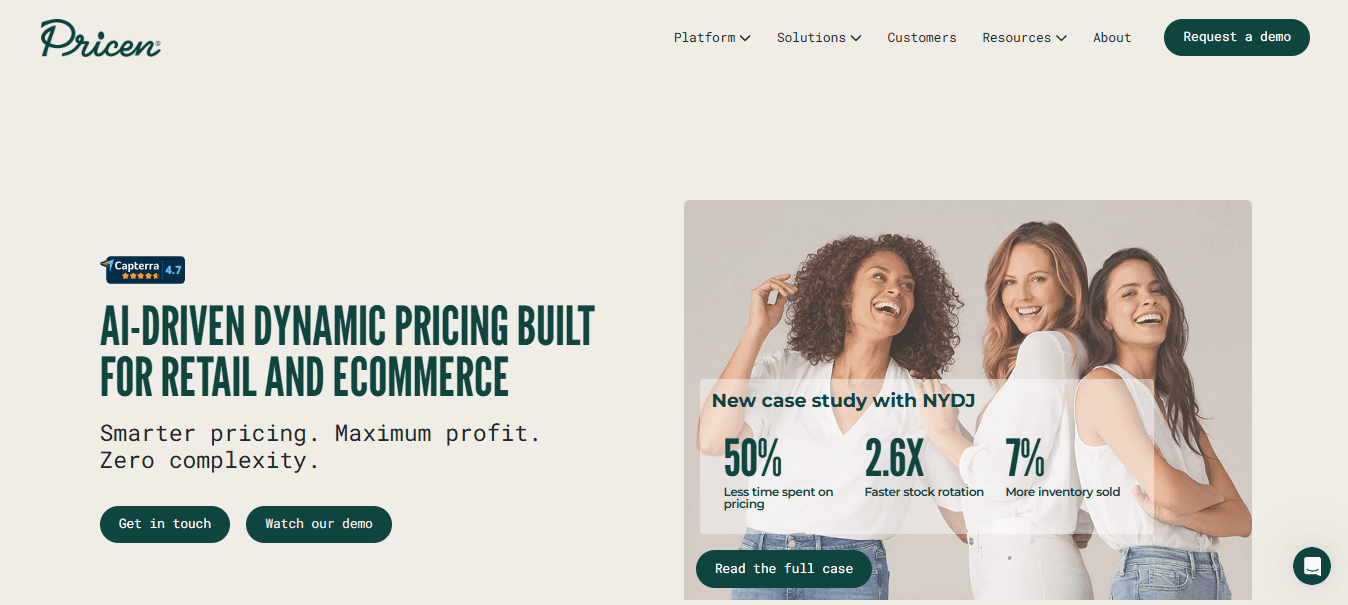
Pricen.ai recommends and applies dynamic prices based on competitor moves, inventory, and market signals to maximize revenue and margin.
Key Features
Real-time competitor and market analysis
Supports international pricing strategies
Detailed reporting and analytics
eCommerce Impact
Increases revenue and margin with automated price optimization.
33. Signifyd: Fraud Protection with Revenue Recovery
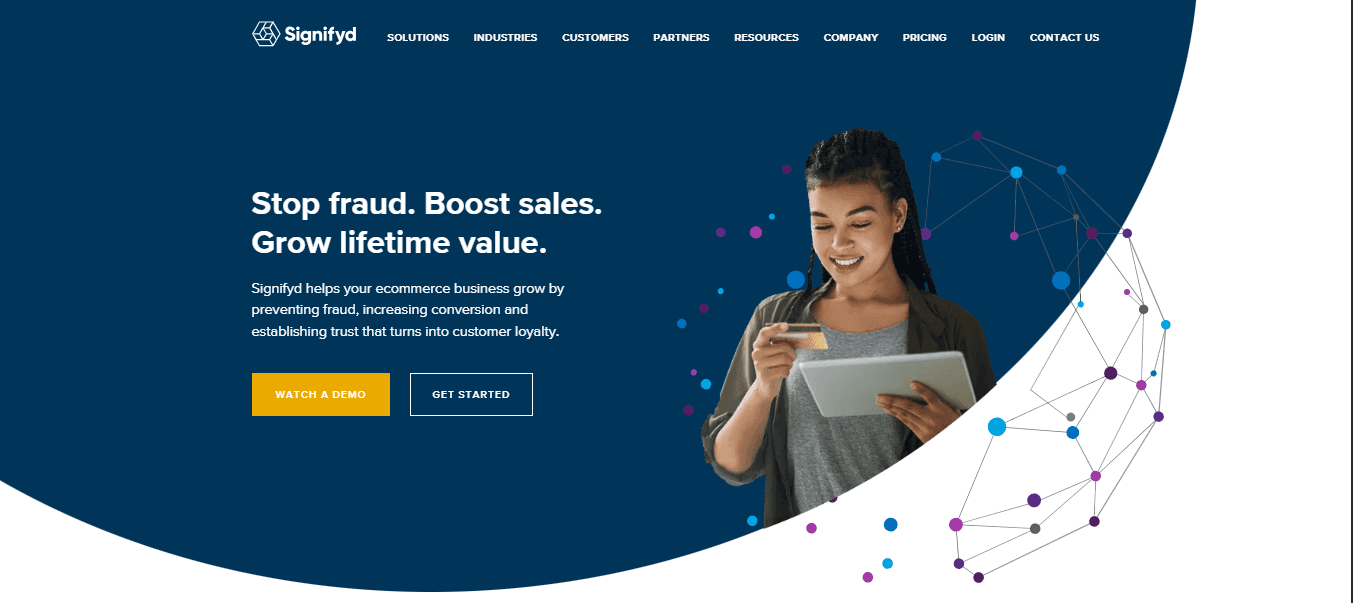
Signifyd uses machine learning and behavior analytics to block fraud and offer chargeback protection so you can approve more legitimate orders.
Key Features
Real-time fraud decisions and automation
Chargeback protection for covered orders
Easy integration with ecommerce platforms
eCommerce Impact
Reduces chargebacks and increases conversion by approving more good orders.
34. Kount: Enterprise Grade Fraud Defense
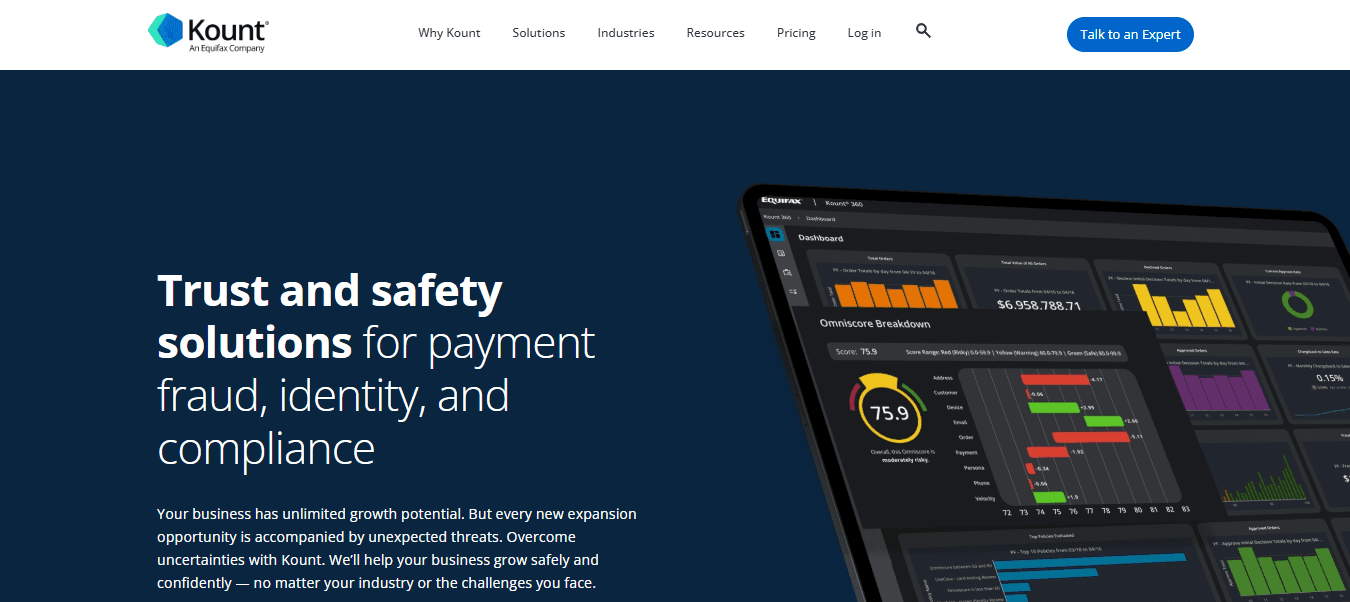
Kount uses adaptive analytics and risk scoring to detect fraud, verify identity, and reduce false positives across enterprise transactions.
Key Features
Advanced risk scoring and adaptive models
Designed to reduce false positives and improve approvals
Scales for large enterprise needs
eCommerce Impact
Protects revenue and lowers operational friction caused by fraud investigations.
35. Riskified: Chargeback Protection with AI Backing
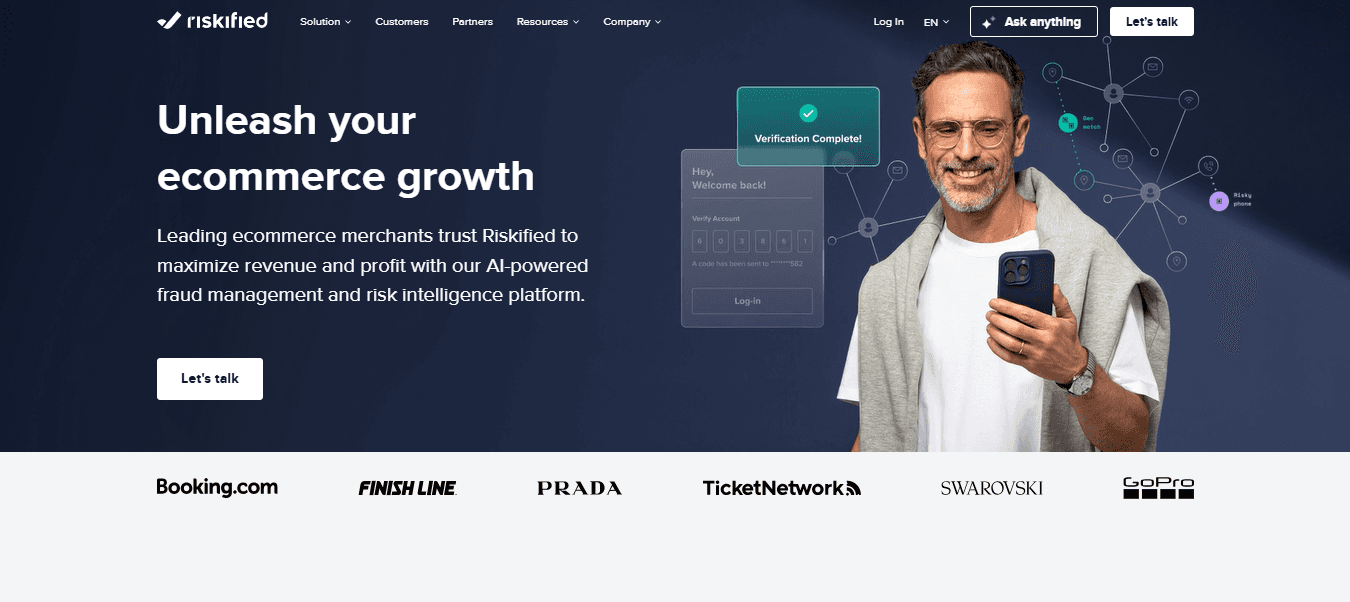
Riskified evaluates transactions with machine learning and offers a chargeback guarantee model that shifts liability for fraudulent orders.
Key Features
AI-driven approval and risk assessment
Chargeback guarantee to protect merchants
Straightforward API integrations
eCommerce Impact
Maximizes approval rates and reduces fraud losses while simplifying risk management.
Related Reading
Book a Free AI Strategy Call with our Team & Check Out our Free Training ($500k/mo in Less Than 2 years)
AI Acquisition helps professionals and business owners start and scale AI-driven businesses that sell services, products, or managed solutions. We combine accessible AI tools with our proprietary AI-clients.com AI operating system, enabling you to move fast. Who wins here?
Individuals with expertise in sales, marketing, operations, or a niche industry seeking to leverage their experience into recurring revenue without the need to develop models from scratch. What skills do you already have that could plug into this system?
How the ai-clients.com AI Operating System Runs the Work
Our platform connects existing AI tools and automations into repeatable workflows. AI handles prospecting, lead qualification, content creation, ad optimization, customer support, and reporting while the operator focuses on strategy and client relationships.
The system uses templates for outreach, onboarding, and delivery, so you avoid reinventing the wheel and you scale predictably. Want to see the workflows that take hours and shrink them to minutes.
How to Start Without Code or Big Capital
You do not need a technical background, expensive infrastructure, or to trade your current job for another 9-to-5 role. We map your skills to a productized offer, plug affordable AI tools into our OS, and assemble sales funnels that convert.
You can launch with low upfront spend and iterate using:
A/B testing
Conversion rate optimization
Campaign analytics
It grows revenue. Ready to test a lean offer this month
Proof From Real Results and the Free Training
I used this exact system to go from a burned-out corporate director to making $500,000 per month in under two years. The free training walks through the step-by-step method, tools used, and how revenue scaled as processes were automated.
Watch the training to see specific funnels, pricing, and client retention tactics that made growth repeatable. Would you like the link to the training or to a case study?
AI Tools for eCommerce: We Plug Into Your Business
We leverage product recommendation engines, personalization engines, chatbots, and virtual assistants for customer interaction, and inventory management systems that sync with fulfillment.
We use demand forecasting and predictive analytics for:
Stock planning
Dynamic pricing for margin optimization
Visual search and image recognition to speed product discovery
For ads and traffic, we run automated advertising, programmatic campaigns, and PPC optimization tied to analytics dashboards. Customer segmentation, CRM integration, email automation, fraud detection, and logistics optimization close the loop on acquisition and retention.
Which of these would change your current operation fastest?
How We Turn Existing Skills into a Chargeable Offer
We audit your experience, identify a niche, and design a productized service or SaaS adjacent offer.
Examples include:
AI-assisted eCommerce growth services
Managed personalization
Automated ad creative creation
Fulfillment optimization consults
Pricing models range from monthly retainers to performance fees and productized packages that scale with AI-driven delivery. Which pricing model matches your tolerance for risk and reward
Book a Strategy Call or Try the Training
If you want a one-on-one review, book an AI strategy call with one of our consultants to map your skills to a launch plan. The call explores offer design, tech stack choices, revenue projections, and a 90-day action plan you can start executing immediately.
Would you like help scheduling a session right now
Related Reading
AI Communication Tools
AI Tools for Customer Success


